ᒫᒪᐘᐢᑖ ᓈᐘᐩ , ᒣᒁᐨ , ᐁᑿ ᓃᑳᐣ
mâmawastâ nâway, mekwâc, ekwa nîkân
kunakes Ahpikahteykin Mey’oosnzah, Noongkom sikwa Ootih Niigkan
Owabi neh, don yachene, Tausum-geh yapka, Naha aba-neh, Tauda-bage yacemte


Īts’ītɫúnī wúnàdí, dā-hī, wúsā
Appotsipiistop kipaitapiiyssinnoon
YanisĮ duhų chu yanathe atłaghetł’ų
Pilrariq: Taimani, Hadja Hivunirmilu

Braiding Past, Present and Future





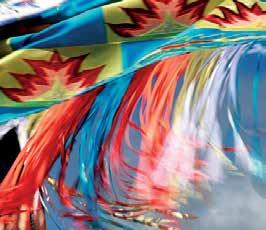
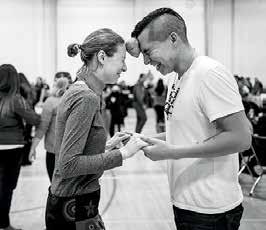


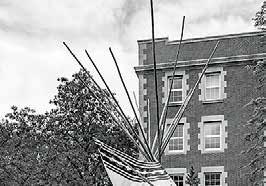

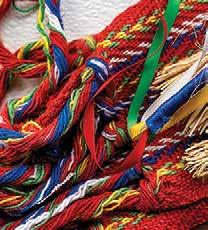


Tresser le passé, le présent et le futur

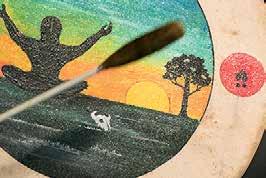

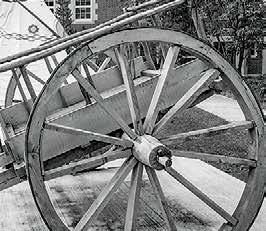
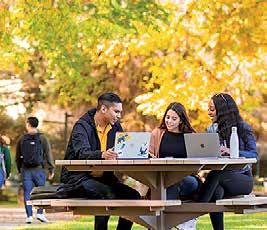


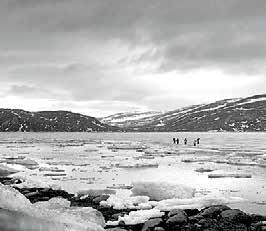



University
Indigenous
of Alberta
Strategic Plan
Territorial Acknowledgment

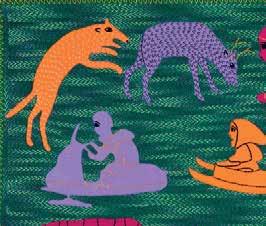
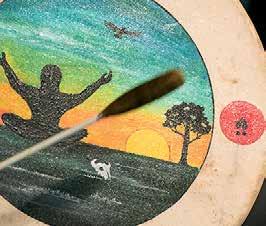

The University of Alberta, its buildings, labs and research stations are primarily located on the territory of the Néhiyaw (Cree), Niitsitapi (Blackfoot), Métis, Nakoda (Stoney), Dene, Haudenosaunee (Iroquois) and Anishinaabe (Ojibway/ Saulteaux), lands that are now known as part of Treaties 6, 7 and 8 and homeland of the Métis. The University of Alberta respects the sovereignty, lands, histories, languages, knowledge systems and cultures of all First Nations, Métis and Inuit nations.
To acknowledge the territory is to recognize the longer history of these lands. The acknowledgment signifies the University of Alberta’s commitment to working in Good Relations with First Nations, Métis and Inuit peoples as we engage in our institutional work, uplifting the whole people, for the university for tomorrow.
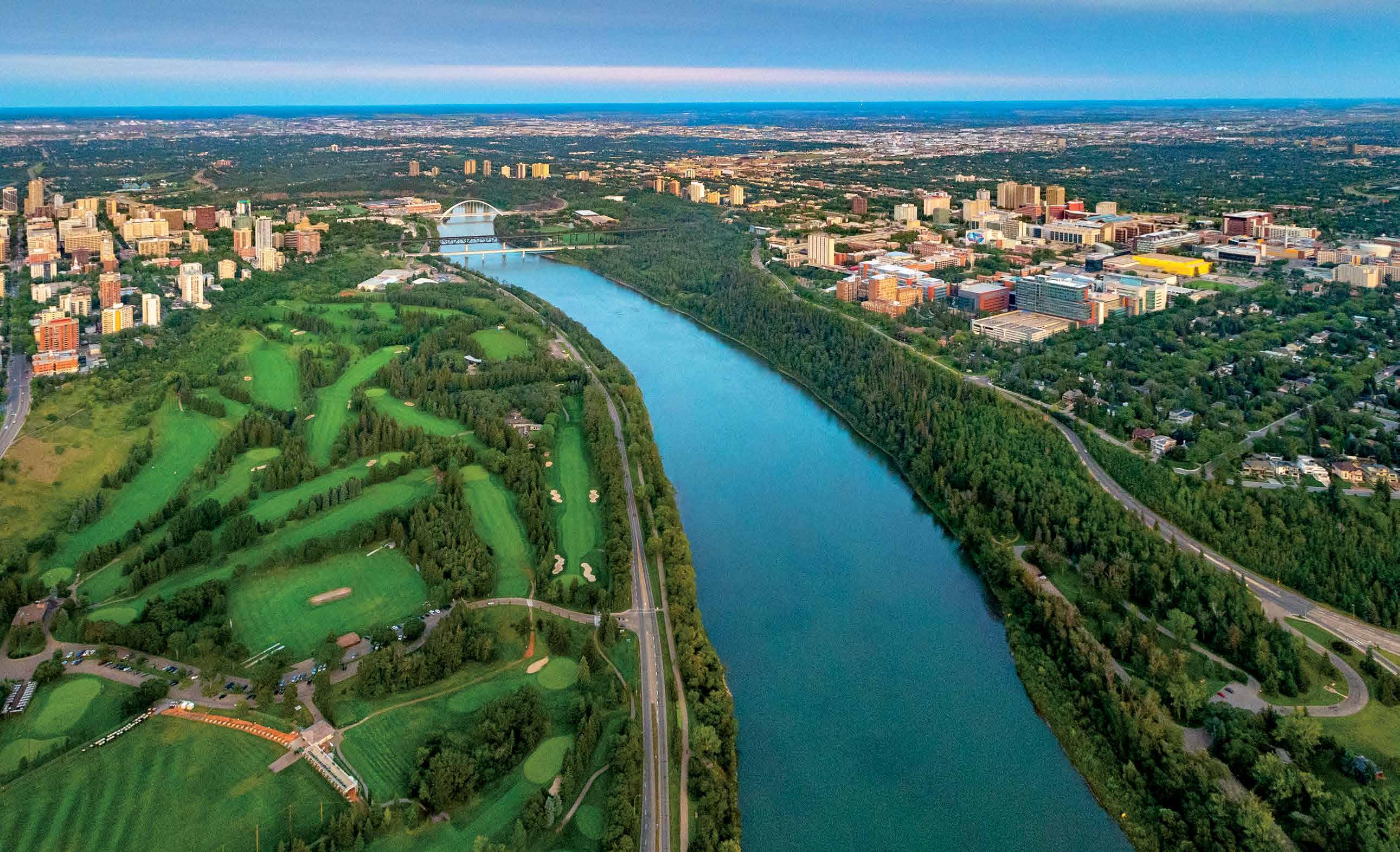
PHOTO BY RICHARD SIEMENS 3 UNIVERSITY OF ALBERTA INDIGENOUS STRATEGIC PLAN 2 BRAIDING PAST, PRESENT AND FUTURE
51
Looking to the Past
57
In-Powering the Present
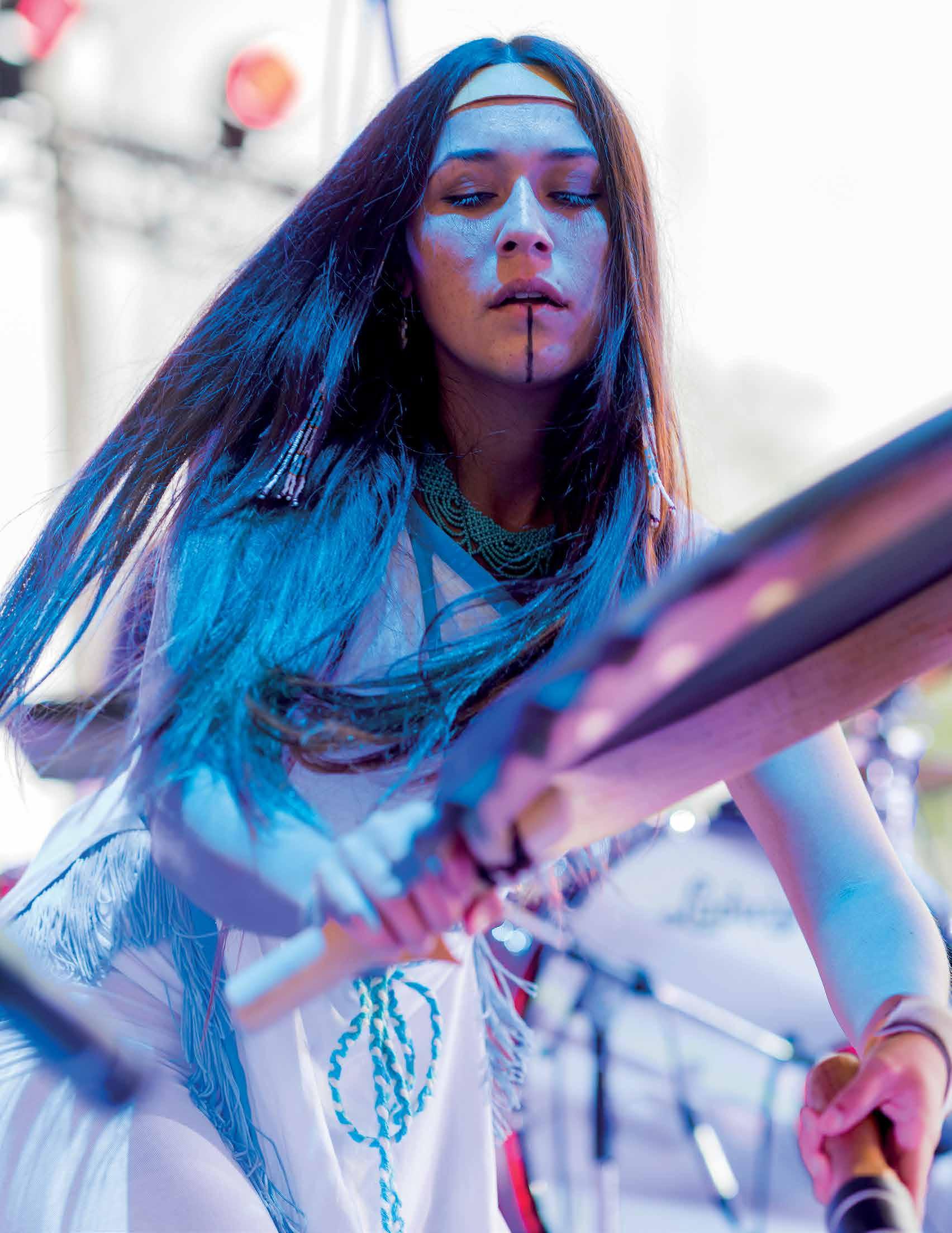
61
Imagining the Future
Table of Contents
RIGHT AND FOLLOWING PAGE PHOTOS BY JOHN ULAN
ᑲᐱᒧᑕᑕᐟ University
2 Territorial Acknowledgment 8 Gratitude 10 Ceremony 11 Indigenous Self-Determination 12 University of Alberta Vision and Mission 14 Guiding Values and Principles 15 Indigenous Terminology 16 Message from the Vice-Provost, Indigenous Programming and Research 19 Message from the President and Vice-Chancellor 22 Introduction 34 University of Alberta Response 36 Dialogues 38 Nisitohtamowin (Understanding) 38 The Sweetgrass Teachings as Shared by Elder Fernie Marty 40 Braiding Past, Present and Future: University of Alberta Indigenous Strategic Plan 42 Where We Are in the Journey 48 Themes, Goals and Strategies 65 Endorsement by University Governance 68 Affirmation for Action by the University Community 71 Endnotes
Lawyer and Inuit throat singer Jenna Broomfield, a U of A grad, at a performance with Tanya Tagaq at the Interstellar Rodeo in Edmonton in July 2015.
Beadwork on the cover: kiskinohawmatok 2018; ᐊᐢᑭ
of Alberta Museums Art Collection, University of Alberta Museums; 2018.4.1. Used with
permission.
Co-ordination
51 Indigenous Leadership and
52 Accountability and Reporting
and Scholarship
University
Participation in Reconciliation
52 Indigenous Ways of Knowing: Programs 53 Relationship with Indigenous Lands and Nations 53 Indigenous-Centred Policy, Protocol and Praxis 53 Reconciliation Research
54
of Alberta Community
Attainment:
and Retention
Safe and Welcoming Spaces
57 Indigenous Students: Recruitment, Retention and Completion 58 Indigenous Student
Tackling Barriers 58 Indigenous Faculty and Staff: Recruitment
59
and Knowledge Systems
Research Capacity Development
Engagement:
and Peoples
Engagement: University of
Senate
Engagement:
Alumni
Innovative Funding 4 PILRARIQ: TAIMANI, HADJA HIVUNIRMILU 5 UNIVERSITY OF ALBERTA INDIGENOUS STRATEGIC PLAN
61 Ethical Research Engagement: Indigenous Nations, Peoples, Lands
62 Indigenous-Led
63 Indigenous Community
Nations, Organizations
64 Indigenous Community
Alberta
64 Indigenous Community
University of Alberta
64
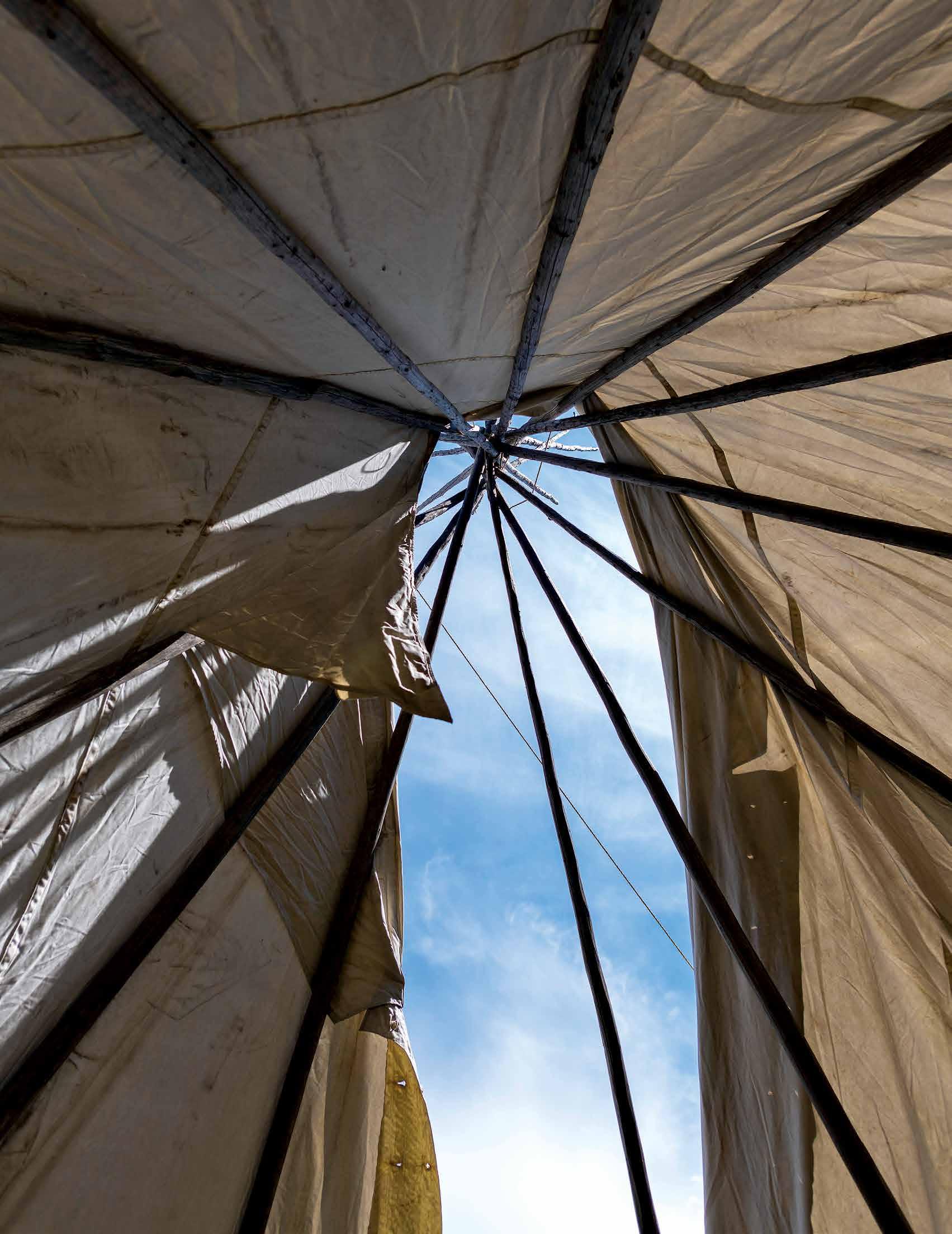
“ The resurgence of Indigenous Peoples has been carried by those who came before us and the individuals today working to tackle the deliberate aim of the erasure of Indigenous knowledge systems and Peoples.”
Florence Glanfield
6 ᒫᒪᐘᐢᑖ ᓈᐘᐩ , ᒣᒁᐨ , ᐁᑿ ᓃᑳᐣ 7 UNIVERSITY OF ALBERTA INDIGENOUS STRATEGIC PLAN
Vice-Provost, Indigenous Programming and Research; Professor, Faculty of Education
Gratitude
With gratitude, we acknowledge our ancestors for the strength of spirit that is our inheritance from the endless generations that came before. We honour our ancestral lines, carrying forward the gifts, responsibilities and hopes that they bequeathed us.
We offer thanks to the Elders, Indigenous leaders, students, colleagues, alumni and non-Indigenous allies at the University of Alberta for the courageous and often difficult work that they have done in the past to lead us to this moment. We are grateful for the opportunity to honour them by carrying this work forward.

We acknowledge the many Elders and Knowledge Keepers that currently work with the university as advisers, spiritual leaders, teachers and community advocates. The work of the university across spaces including research, student supports, community engagement and curriculum is supported by the many relationships with diverse Elders and Knowledge Keepers. They have generously shared their knowledge and time
with the university, helping the institution to ground its work in Indigenous teachings and move toward richer conceptions of reconciliation.
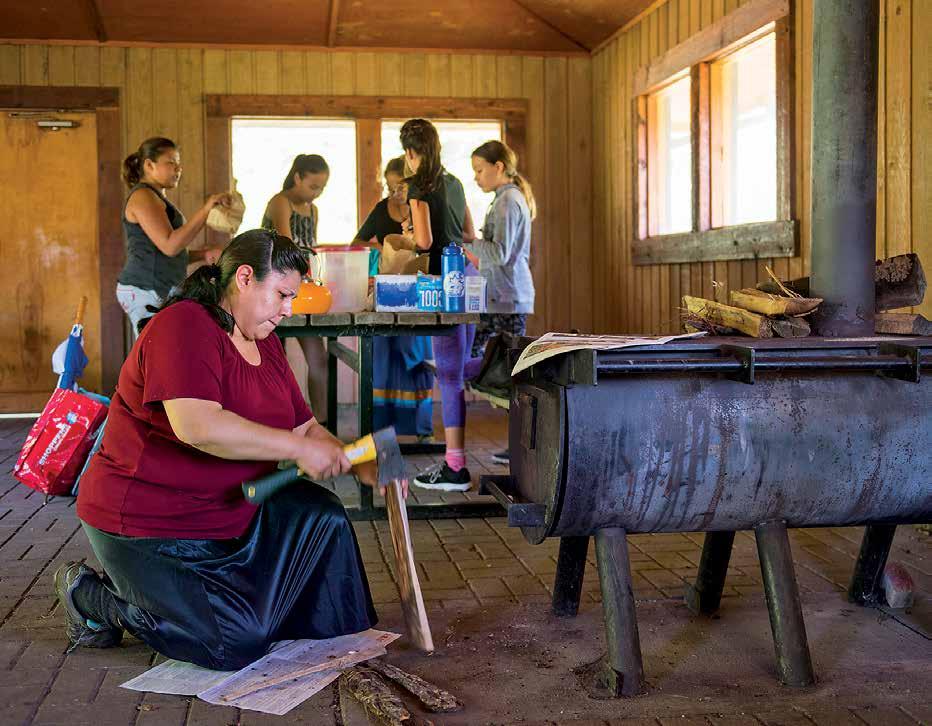
We are grateful to Elder Fernie Marty for sharing his knowledge of the Sweetgrass Teachings, to Dr. Carl Urion and Elder Elmer Ghostkeeper for the teachings about the University of Alberta’s journey, and to Doreen Daychief, Edna Elias, Elmer Ghostkeeper, Dorothy Thunder, Gil Anderson, Lyndon Aginas, Dr. Betty Bastien, Isadore Kootenay, Phillip Cardinal and Lynda Minoose for their sharing of the translations of “braiding past, present and future” into their respective Indigenous languages, which appear throughout this document.
Many of our diverse Indigenous communities, the original humans of these lands, share the same values, laws and relationship of our living relative — nikawiy asiskiy (Mother Earth). The buffalo has become a symbol of education but also represents the Law of Sharing. The laws and policies of this nation-state have continuously attempted to disconnect Indigenous Peoples of their kinship right to protecting, connecting and honouring our living land, and heartbased education led by Indigenous leaders has been our tool of surviving changes and reconnecting to be humans of this living land once again. The Indigenous Strategic Plan (ISP) carries the prayers of our ancestors through a vision and mission to help (re) connect good relationships to our mind, body and spirit, but also to one another, and our communities through policy changes that reflect the values, laws and relations of our living relative nikawiy asiskiy.”
 Lana Whiskeyjack
Professor,
Assistant
Faculty of Arts, Women’s and Gender Studies
The Young Indigenous Women’s Circle of Leadership creates opportunities for participants to learn about aspects of their culture and identity through various activities, rooted in nehiyawewin (Cree language).
Lana Whiskeyjack
Professor,
Assistant
Faculty of Arts, Women’s and Gender Studies
The Young Indigenous Women’s Circle of Leadership creates opportunities for participants to learn about aspects of their culture and identity through various activities, rooted in nehiyawewin (Cree language).
9 UNIVERSITY OF ALBERTA INDIGENOUS STRATEGIC PLAN 8 YANISĮ DUHŲ CHU YANATHE ATŁAGHETŁ’Ų
An encampment on Rossdale Flats, April 1919. Provincial Archives of Alberta, B882.
LEFT PHOTO BY JOHN ULAN, RIGHT PHOTO GETTY IMAGES
Ceremony
We give thanks to Elder Dr. Francis Whiskeyjack for leading ceremony to begin this work in a Good Way. In acknowledgment of the difficulty of the work and the teachings needed for the path ahead, a group of Indigenous colleagues and University of Alberta senior leaders participated in ceremony and discussion, committing themselves to the work of the Indigenous Strategic Plan and Indigenous Initiatives more broadly.
Indigenous Self-Determination
The principle of the Indigenous right to self-determination informs work to ensure that this strategic plan, and other Indigenous initiatives at the University of Alberta, are Indigenousled. We offer thanks to the 22-member Indigenous Advisory Council (IAC) for their leadership and direction on the development of this strategic plan, as well as the far-ranging commitments to First Nations, Métis and Inuit-focused work and peoples, as outlined in For the Public Good, the University of Alberta’s Strategic Plan for Equity, Diversity and Inclusivity, and the University of Alberta for Tomorrow.
IAC membership included:

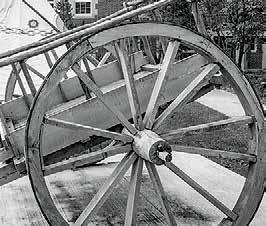
• Chris Andersen, Professor and Dean, Faculty of Native Studies
• Gil Anderson, Academic Services Coordinator, Masters and Professional Programs Office, Alberta School of Business
• Kateryna Barnes, Communications Associate, External Relations
• Dallas Cardinal, Project Co-ordinator, Supporting Indigenous Languages Revitalization, Office of the Vice-Provost, Indigenous Programming and Research
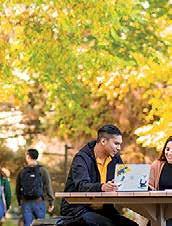
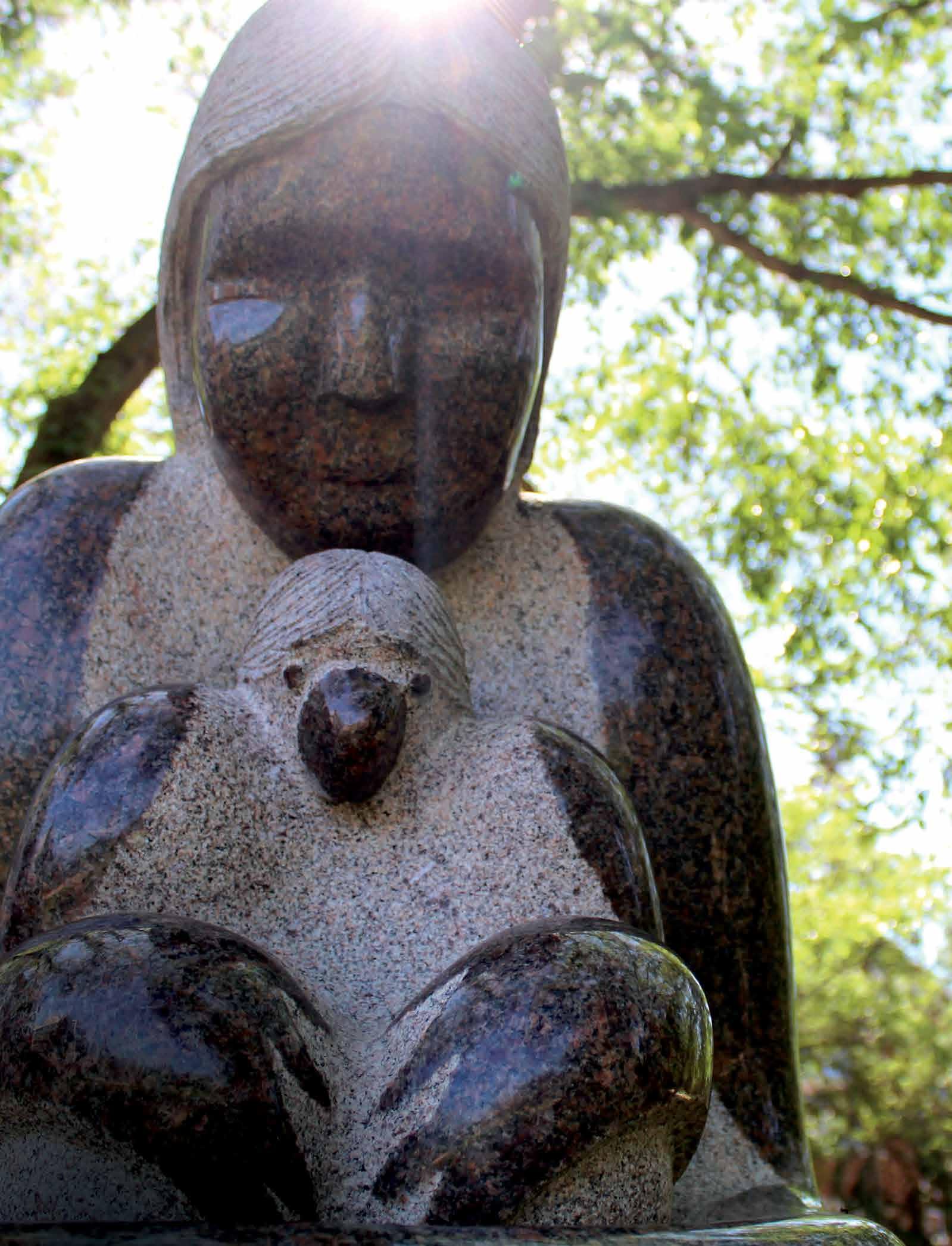
• Freda Cardinal, Senior Co-ordinator, Admissions and Student Services, Faculty of Native Studies
• Wayne Clark, Executive Director, Indigenous Health Initiatives Program, Faculty of Medicine & Dentistry
• Shana Dion, Assistant Dean, First Nations, Métis and Inuit Students, Student Services – Dean of Students Administration
• Dwayne Donald, Professor, Faculty of Education
• Michelle Durocher, Executive Assistant, Corporate and Foundation Relations, External Relations
• Paul Gareau, Assistant Professor, Faculty of Native Studies
• Cindy Gaudet, Assistant Professor, Campus Saint-Jean
• Florence Glanfield, Vice-Provost, Indigenous Programming and Research; Professor, Faculty of Education
• Tracey Hillier, Associate Professor, Faculty of Medicine & Dentistry; Alberta Institute, Wenzhou Medical University, Faculty of Medicine & Dentistry – MED International; Co-Director, Situated Knowledges: Indigenous Peoples and Place (SKIPP) Signature Area
• Valerie Hunter, HR Service Partner, Human Resource Services –Partnerships
• Pamela McCoy Jones, Executive Director, Supporting Indigenous Languages Revitalization, Office of the Vice-Provost, Indigenous Programming and Research
• Ceilidh Morrissette, Research Co-ordinator, Faculty of Arts –Humanities Administrative Services
• Cindy Paul, Copyright Specialist, Library and Museums – Copyright Office
• Trevor Phillips, Manager, Indigenous Recruitment, Office of the Registrar
• Nella Sajlovic, Indigenous Strategies Manager, Office of the Vice-Provost, Indigenous Programming and Research
• Jessica Vandenberghe, Assistant Dean, Engineering Community and Culture, Faculty of Engineering; President-Elect, Alumni Council
• Lana Whiskeyjack, Assistant Professor, Faculty of Arts, Women’s and Gender Studies
• Willow White, Assistant Professor, Augustana, Fine Arts & Humanities
Members of the IAC who served prior to their resignations from the council:
• Bev Findlay, Administrative Assistant, Faculty of Native Studies
• Jessica Kolopenuk, Assistant Professor, Faculty of Native Studies
• Kayla Lar-Son, Indigenous Academic Resident, Libraries, Digital Initiatives
• Daniel McKennitt, Post-Doctoral Fellow, Faculty of Medicine & Dentistry
• Daniel Sims, Assistant Professor, Augustana
• the late Jennifer Ward, Educational Developer, Centre for Teaching and Learning – Instructional Services
10 ĪTS’ĪTⱢÚNĪ WÚNÀDÍ,
11 UNIVERSITY OF ALBERTA INDIGENOUS STRATEGIC PLAN
Eaglechild (2012) by Stewart Steinhauer of Saddle Lake Cree Nation. The Eaglechild story is a post‑apocalyptic narrative where a sole human survivor, an infant, is rescued, nurtured, and transformed into a part eagle part human creature and educated in the cultural teachings of their human ancestors, by non‑human forces. It is an example of oral transmission of cultural knowledge, in the cycle of creation stories from which it comes.
DĀ-HĪ, WÚSĀ
University of Alberta Vision and Mission
Vision
The University of Alberta vision is to inspire the human spirit through outstanding achievements in learning, discovery and citizenship in a creative community, building one of the world’s great universities for the public good.

Mission
Our mission is to create and sustain a vibrant and supportive learning environment that discovers, disseminates and applies new knowledge through teaching and learning, research and creative activity, community involvement, and partnerships. The University of Alberta gives a national and international voice to innovation in our province, taking a lead role in placing Canada at the global forefront.
These statements represent the core values and mandate of the University of Alberta. Tasked with “inspiring the human spirit” and “taking a lead role in placing Canada at the global forefront” requires a reflection on the history of our institution and of this nation we now call Canada as a whole, particularly in relation to Indigenous Peoples, acknowledging the complex and often negative history between this nation and the Indigenous Peoples of this land. The University of Alberta has an important role to play in fostering reconciliation and acknowledging Indigenous rights, territories, knowledge and worldviews. We must also acknowledge the ongoing impacts of colonial thinking within our institution and the barriers that may not always be apparent to the inclusion of Indigenous Peoples.
This strategic plan has the vision and potential to hold the University of Alberta accountable as an institution invested in a reconciled future for First Nations, Métis and Inuit learners.”
 Trevor J. Phillips Manager, Indigenous Recruitment, Office of the Registrar
Trevor J. Phillips Manager, Indigenous Recruitment, Office of the Registrar
As an Indigenous professional engineer, I think it is vital that the University of Alberta take up the Calls to Action, especially knowing the oppressive history and present towards First Nations, Métis and Inuit. We have a role to play to create future leaders from all faculties who see the Truth and understand why it is vital to actively participate in reconciliation no matter where their alumni journey takes them. Our leaders must lead in this space and come from a place of creating equitable policies, frameworks, attraction and retention
strategies, and wellness supports while showing up authentically while we implement the Indigenous Initiatives strategy. This needs to be top priority not only in strategic plans but in everyday actions, behaviours and conversations. We need to hold each other accountable so that we can be proud of how we walk together in a Good Way.”
Jessica Vandenberghe Assistant Dean, Engineering Community and Culture, Faculty of Engineering; President‑Elect, Alumni Council
Elder Evelyn Day, left, tours a lab with Jessica Vandenberghe, assistant dean and Industry Professor, Indigenous Engineering.
12 BRAIDING PAST, PRESENT AND FUTURE 13 UNIVERSITY OF ALBERTA INDIGENOUS STRATEGIC PLAN
LEFT PHOTO BY JORDON HON; RIGHT PHOTO BY JOHN ULAN
Guiding Values and Principles
The guiding values and principles that underpin Braiding Past, Present and Future: University of Alberta Indigenous Strategic Plan include:
All My Relations
Acknowledging the interconnectedness, interdependence, worth and mutual responsibility of all peoples, creatures and lands; a common conceptualization of all things living among Indigenous Peoples; known as wahkohtowin by the Cree and Métis
Decolonization
Repudiating the racist justifications and dismantling the colonial structures aimed at disenfranchising Indigenous Peoples of their legal, social, cultural, religious and ethnic rights; reclaiming Indigenous identity, language, culture and worldviews
Inclusivity
Validating the value of, and enacting work to provide, equal access to opportunities, resources, experiences and education to those excluded or marginalized from greater access
Indigenization
A process of highlighting and incorporating Indigenous worldviews, knowledge and perspectives into non-Indigenous educational, political and social structures in recognition of exclusion and erasure; celebrating the diversity, strength, complexity, resilience and beauty of Indigenous Peoples, cultures, languages and knowledge systems
Indigeneity
Belonging to specific lands and places; the unlimited right to self-identification by Indigenous Peoples
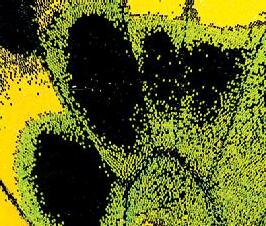
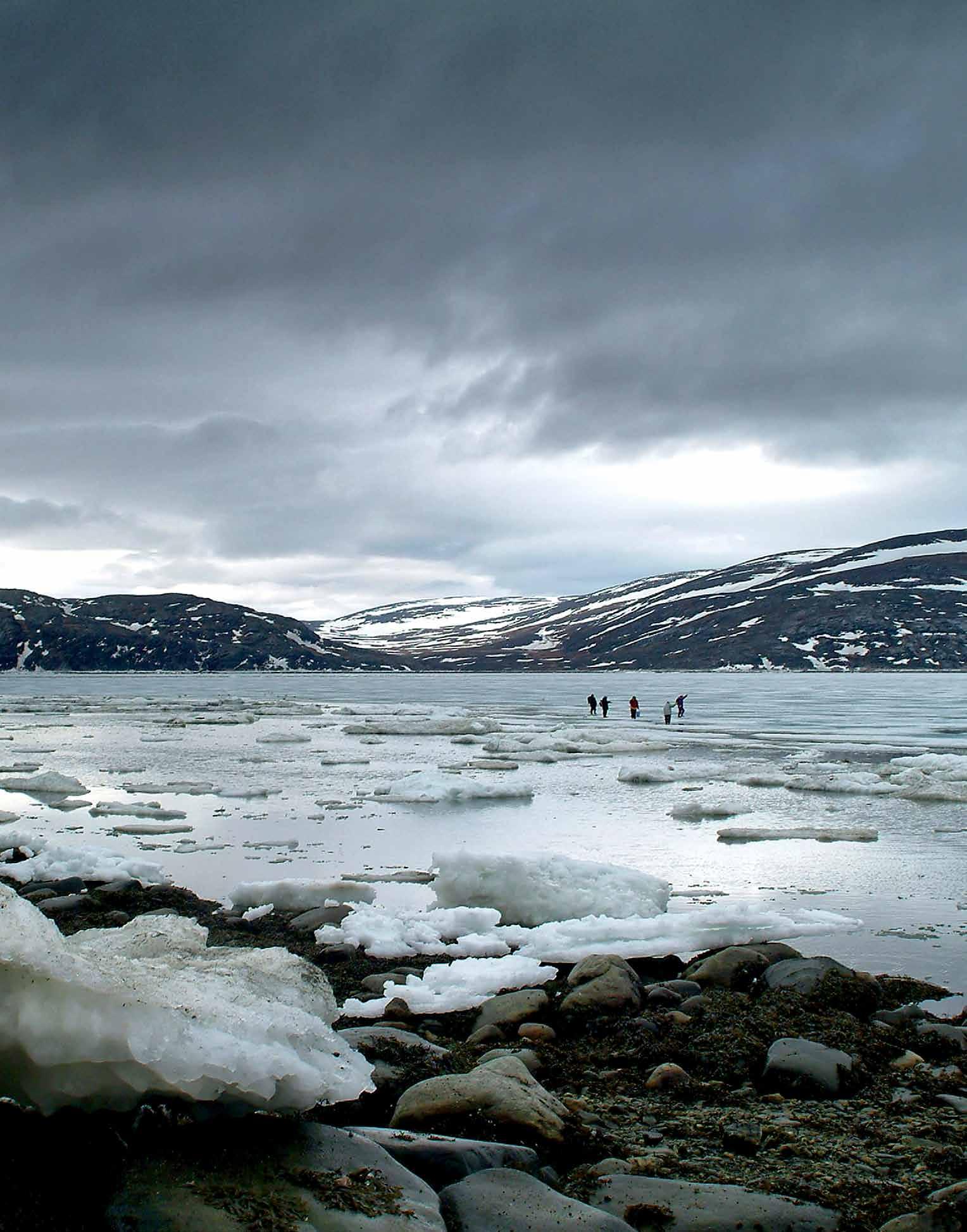
Indigenous Ways of Knowing, Being and Doing

Affirming the validity, diversity, sophistication and beauty of Indigenous understandings, practices and modes
of learning from the people, animals and plant nations; acknowledging the holistic viewpoints of Indigenous Peoples that take into account the whole person (mind, body, spirit) and the connection to peoples, lands and living things
Intersectionality/Confluence
Recognizing the relationship between various constructed categories such as race, gender, sexual orientation, class and all forms of ableism that inform the converging influences of systems of oppression as they occur on Indigenous territory
Reconciliation
The Truth and Reconciliation Commission of Canada (TRC) defines reconciliation as an ongoing process of establishing and maintaining respectful relationships between Indigenous Peoples, the state and non-Indigenous peoples


Self-Determination
The inherent right of Indigenous nations, communities and Peoples to determine their political status and freely pursue economic, educational, social and cultural development
Sovereignty
The inherent right of Indigenous nations, communities and Peoples to autonomy, legitimacy and recognition as self-determining authorities
Strength-Based Approach
A focus on the strengths and competencies of individuals and communities and an acknowledgment of structural barriers in opposition to deficit narratives that perpetuate inequity by assuming deficiencies
As a young boy growing up in Alberta, it was everywhere evident to me the long and troubled history of the colonization and exclusion of the Indigenous Peoples of these lands. We all must commit to changing this legacy. I am proud of the more recent record of the University of Alberta’s broad commitment to advancing Truth and Reconciliation. None of our many initiatives is more important than our Indigenous Strategic Plan. It outlines an ambitious vision of the meaningful inclusion of Indigenous Peoples and Indigenous Ways of Knowing in all we do as a university community. I know that all members of the university community will join me in committing to do all we can to advance these goals and ever deepen our commitment to engaging in a meaningful and respectful relationship with the Indigenous Peoples of these lands.”
Bill Flanagan President and Vice Chancellor
Indigenous Terminology
In this document, the term Indigenous is used in the spirit of acknowledging the diverse ways in which the First Peoples of this land now called Canada chose to identify themselves, not how colonial governments have identified them, and encompassing the diversity of identity captured in First Nations, Métis and Inuit communities.
Although there is no legal definition of Indigenous in the Canadian context, the use of this naming in this document is in alignment with the growing trend for the use of the term Indigenous by the United Nations, among others. This is embodied by self-identification as Indigenous at the individual level but also through family-community connection; continued occupation of ancestral lands and/or common ancestry with the original occupants of such lands; distinct social, economic or political systems; and distinct language, culture and beliefs.
GETTY IMAGES 15 UNIVERSITY OF ALBERTA INDIGENOUS STRATEGIC PLAN 14 AHPIKAHTEYKIN
MEY’OOSNZAH, NOONGKOM SIKWA OOTIH NIIGKAN
Message from the Vice-Provost, Indigenous Programming and Research
I am a member of the Métis Nation of Alberta with deep ties to kin across Alberta. The Lac La Biche-Fort McMurray region was the foundation of my early life. It was from northeastern Alberta that I first came to the University of Alberta to begin my first degree in 1976. The university has played a central role in my life, providing the formal educational experiences behind my career as a teacher, researcher, professor of mathematics education and leader.
is but one piece of the work to correct the historical record and give voice to silenced narratives that significantly impact the lived experiences of Indigenous Peoples.


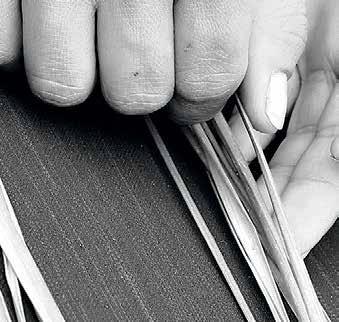
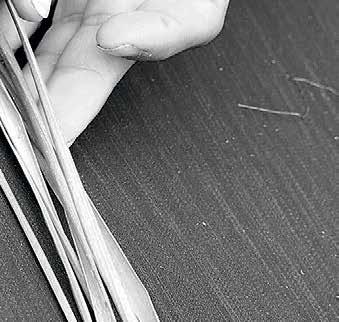
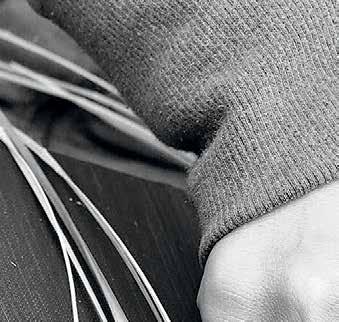
The first seven are the generations that preceded us: they walked the journey to bring us to where we stand today. The second seven strands represent the seven sacred teachings. The third seven strands represent the seven generations yet to come. We, as humans of this Earth, acknowledge our responsibility to those not yet born, knowing that everything we do in our lifetimes carries forward to impact them. In this way, we are bound through time in honouring the legacy of our ancestors and recognizing that we are responsible for the future.

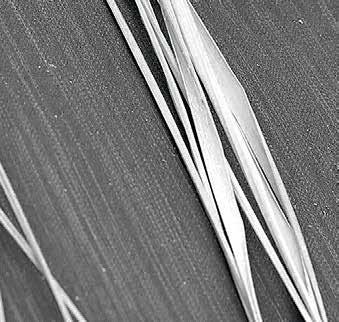
This teaching is at the heart of Braiding Past, Present and Future: University of Alberta Indigenous Strategic Plan. The plan recognizes our collective responsibility to acknowledge our history and to honour those who came before us and to follow the seven sacred teachings — love, respect, honesty, courage, wisdom and humility; to know the first six together is to know truth. The plan also recognizes our responsibilities to the generations to come, knowing that we have the power to leave them a beautiful legacy. In essence: honouring the past, living the present and shaping the future.
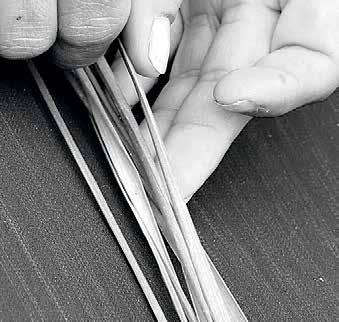
It has been a humbling, joyous and a deep responsibility to lead Indigenous-focused work at the University of Alberta since August 2019. A key focus in the first years of the mandate of the Vice-Provost, Indigenous Programming and Research was the creation of an Indigenous Strategic Plan to bring about the kind of foundational change imagined by the Truth and Reconciliation Commission of Canada (TRC) and the broader expectations that have emerged across organizations and the public.

As a society, we are only just coming into a time where the histories and complex understandings of Indigenous Peoples are being heard in the wider world. From the time of contact, Indigenous Peoples have been standing against assimilative practices aimed at causing them to “cease to exist as distinct legal, social, cultural, religious, and racial entities in Canada.”1 The resurgence of Indigenous Peoples has been carried by those who came before us and the individuals today working to tackle the deliberate aim of the erasure of Indigenous knowledge systems and Peoples.
The confirmation that the remains of Indigenous children have been found at residential school sites across Canada has been a stark reminder of the urgency of the work that the university has committed to in response to the TRC Calls to Action. Long known in community, this






Education has the power to uplift humanity, and universities have a powerful role and responsibility to play in truth and reconciliation. The University of Alberta’s motto, “Quaecumque Vera,” invites the community to pursue “Whatsoever things are true.” As a university community we should be questioning “whose truth?” and we have a responsibility to teach to question the validity of concepts used to justify European sovereignty over Indigenous lands and Peoples.
Undoing the legacy of colonialism and advancing conciliation — that is establishing respectful nation-to-nation relationships — is a difficult journey. It requires generosity, kindness and patience and, above all, it takes unlearning. We, as individuals and as a collective, are only beginning to take steps to “unlearn colonialism” which means in many ways we are still at the beginning of this complex, generational and ultimately non-linear work.
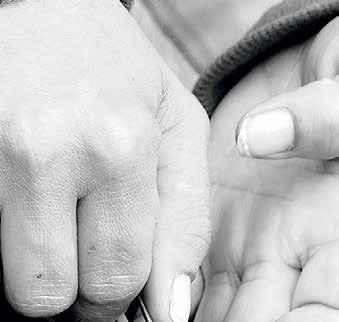
This plan is another step in this work at the University of Alberta and builds on advocacy that has been taking place for 80-plus years. In the 1940s, University of Alberta professors became members of the Indian Association of Alberta (IAA), learning from several of the most distinguished political and spiritual Elders of Alberta. Known as the Friends of the Indians, the professors lobbied the provincial and federal governments, raised funds and publicized injustices. In the 1960s and ’70s, First Nations and Métis Elders and leaders pushed for research and teacher education programs such as
the Morning Star program developed in collaboration with what is now University nuhelot’įne thaiyots’į nistameyimâkanak Blue Quills; this work was the precursor to what we now know as the Aboriginal Teacher Education Program. In the 1970s, an IAA presentation to the University of Alberta Senate led to the development of the School of Native Studies, now the Faculty of Native Studies. These developments are a small part of the wide-ranging efforts undertaken to build a university that ensures that all students can attain their educational and professional goals and that we all live in a more just world. They are also evidence that the concerted efforts of a few have significant, lasting impacts. The mobilization of the many can be world changing.


I am hopeful as the University of Alberta makes progress on the broad goals contained in the three “strands” of past, present and future articulated in this plan. I invite each of you to find yourself in this plan; I invite you to join the work to play your part in conciliation and to sign the Affirmation for Action at the end of this plan. There is so much more work to be done. This plan is a starting point in a long and critical journey that will take generations to achieve.
Florence Glanfield Vice-Provost, Indigenous Programming and Research; Professor, Faculty of Education
The Sweetgrass Teachings tell us that when we plait sweetgrass, we collect 21 strands.
PHOTO BY JOHN ULAN 16 MÂMAWASTÂ NÂWAY, MEKWÂC, EKWA NÎKÂN 17 UNIVERSITY OF ALBERTA INDIGENOUS STRATEGIC PLAN
Message from the President and Vice-Chancellor

As the Territorial Acknowledgment reminds us, the University of Alberta is situated on territory that has been the gathering place of diverse Indigenous nations for thousands of years, a place where diverse peoples, thinkers, scientists, philosophers lived and came to share and exchange knowledge.
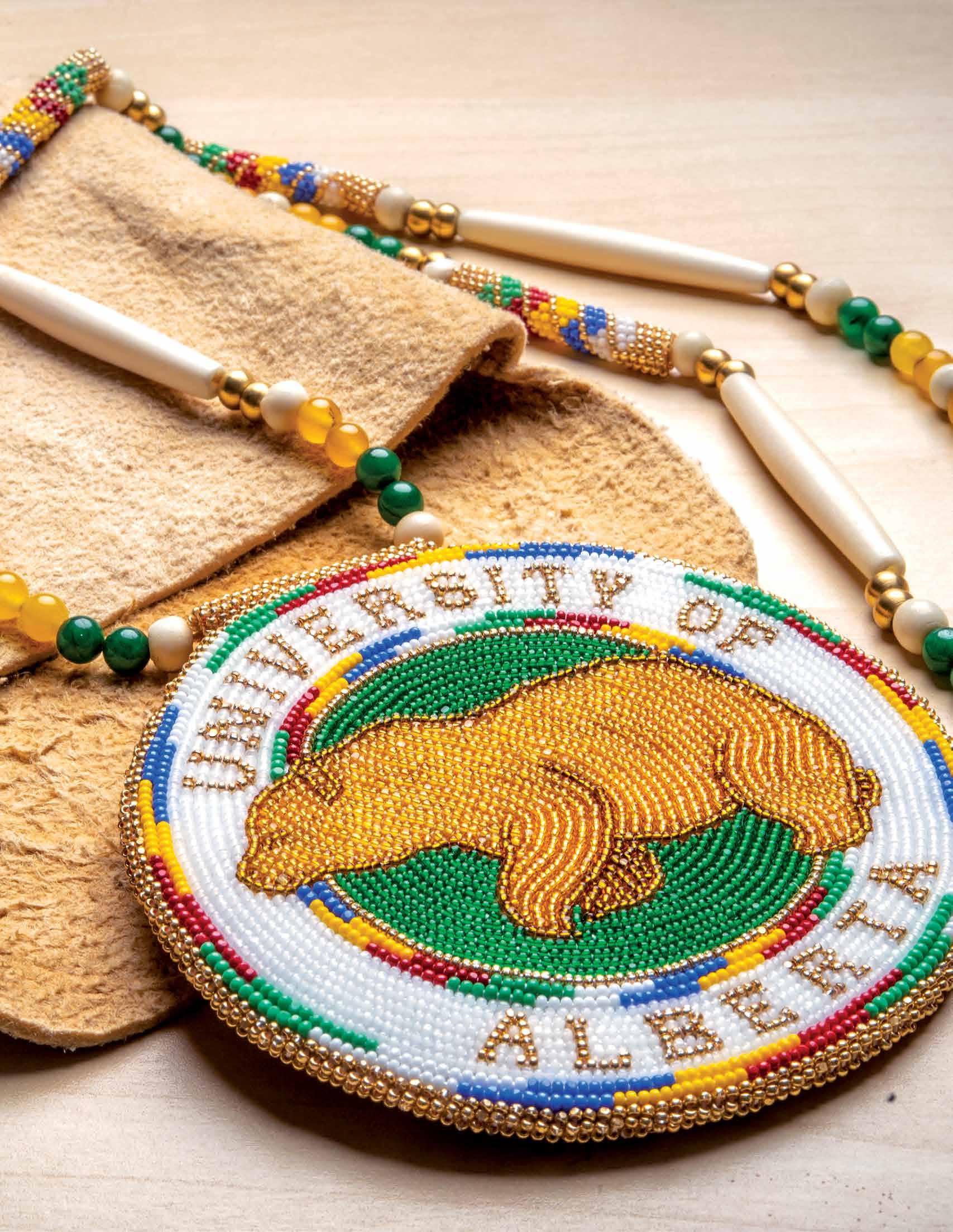
The university is privileged to reside on lands in Treaties 6, 7 and 8. In the spirit of these agreements, the university upholds its commitment to working and living in good relation with each other, respecting the Indigenous Peoples and nations who, through the treaty process, generously offered to share these lands with those who came to these lands from far away.
In recent years, and especially following the work begun by the Truth and Reconciliation Commission of Canada (TRC), a shift in public awareness has illuminated the urgent need to address the structural causes of the long-standing and pronounced inequalities faced by Indigenous Peoples today.
We recognize that the University of Alberta has been part of historic systems that have created barriers to Indigenous sovereignty and wellness. In addressing this history, the University of Alberta has taken steps towards a thoughtful, respectful, meaningful and sustainable response to the Calls to Action issued by the TRC and Indigenous Initiatives more broadly. The Calls to Action are embedded in our institutional strategic plan and are a key pillar of the University of Alberta for Tomorrow.
The Indigenous Programming and Research portfolio was established in the Office of the Provost and Vice-President (Academic) to facilitate Indigenous-led institutional collaboration and communication for the development and implementation of programs, services and initiatives related to Indigenous teaching, learning, research and community engagement.
I want to thank Dr. Florence Glanfield, Vice-Provost, Indigenous Programming and Research for her leadership on this plan and also the members of the Indigenous Advisory Council and broader Indigenous community who crafted this road map.
The Braiding Past, Present and Future: University of Alberta Indigenous Strategic Plan will enable transformative institutional practices that tackle the full scope of these endeavours. Reconciliation is not a destination but a journey in which we all have a part to play. Every step is important in that journey. At its core, the plan is about building better relationships with Indigenous communities — equal, respectful, mutual.
The university’s core mission, in teaching, learning and research, is a commitment to all of the people of this province. It is also a commitment to build and sustain an atmosphere in which, as President Henry Marshall Tory, the first president of the university described it, “prejudice and hatred” cannot live — that is, a university that is committed to the core values of equity, diversity and inclusion of all the peoples and communities that make up our remarkable university and beyond.
I encourage everyone to read this plan and consider the ways in which you can meaningfully engage in reconciliation.
Bill Flanagan President and Vice-Chancellor
LEFT PHOTO BY RICHARD SIEMENS; RIGHT AND FOLLOWING PAGE PHOTOS BY JOHN ULAN 18 BRAIDING PAST, PRESENT AND FUTURE 19 UNIVERSITY OF ALBERTA INDIGENOUS STRATEGIC PLAN
This beadwork was created by Tara Kappo, who is Woodland Cree from Sturgeon Lake Cree Nation in Treaty 8 territory. She began beading at the age of 11 and learned primarily through watching her grandmother. Kappo holds a BA and master’s degree from the Faculty of Native Studies, as well as a Certificate in Indigenous Governance and Partnership.
“ We ask that the Creator bring us clean thoughts, a clean body and a clean spirit. We ask that we remain humble and open to being guided to the lessons that are all around us if our hearts are open.”
Elder

21 UNIVERSITY OF ALBERTA INDIGENOUS STRATEGIC PLAN 20 APPOTSIPIISTOP KIPAITAPIIYSSINNOON
Fernie Marty
Papaschase First Nation
Introduction
At the University of Alberta, the work of Indigenous advocates and allies has led to the truly impactful Indigenous programs, initiatives and course offerings that we know and celebrate today, such as the Faculty of Native Studies, the Transition Year Program, the Aboriginal Teacher Education Program and the Specialization in Indigenous Peoples Education graduate program, to name but a few. This plan acknowledges the courage and strength of the Elders, Knowledge Keepers, Indigenous leaders and allies who “walked the path” to bring about the changes that have allowed us to reach the place we are at in the journey towards Indigenous sovereignty and wellness.
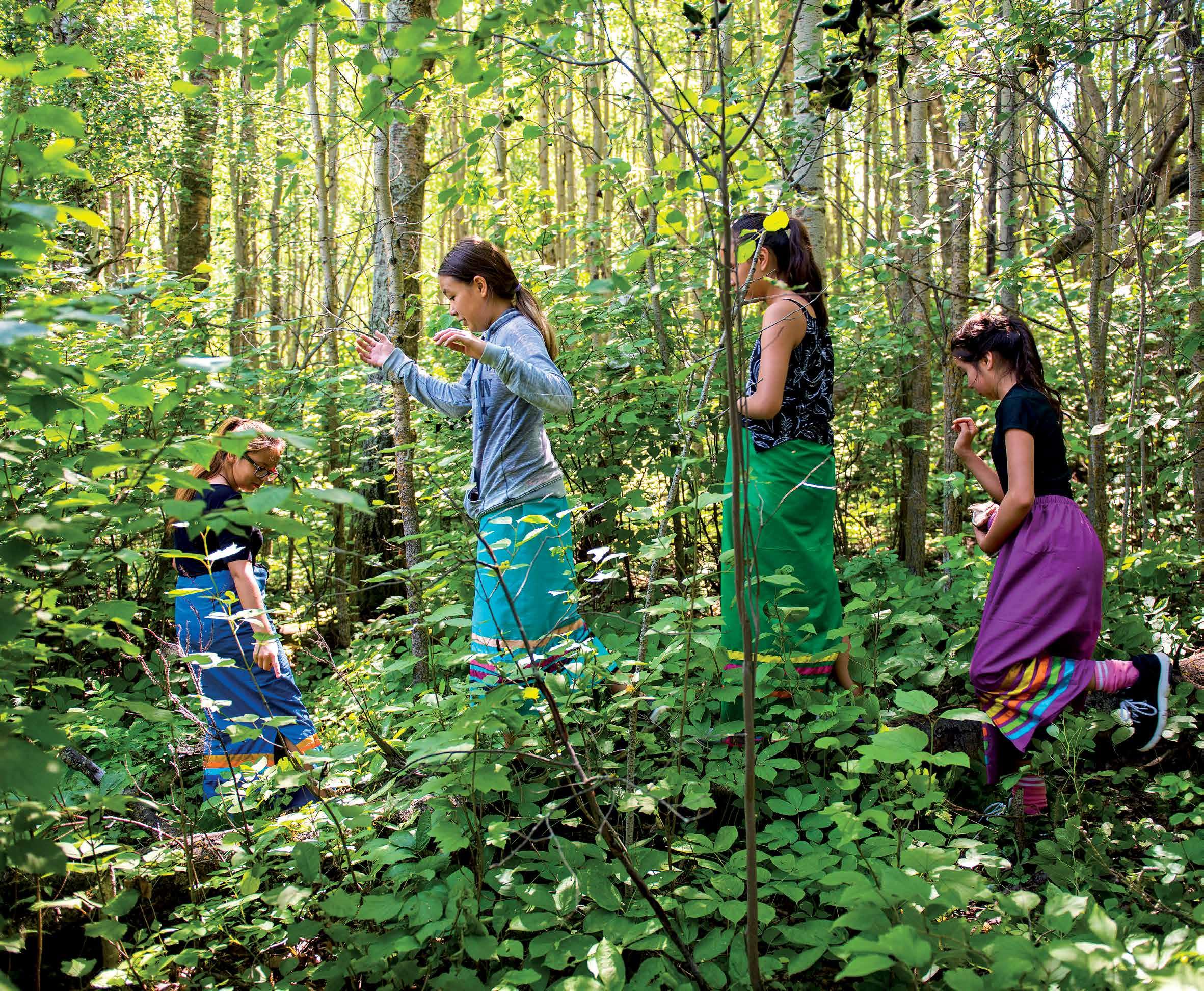
As part of the struggle to address colonialism and its subjugation, Indigenous Peoples have continuously fought against the systems and structures, laws and practices meant to disempower — to assert Indigenous rights and seek a just relationship with the state and beyond.
PHOTO BY JOHN ULAN 23 UNIVERSITY OF ALBERTA INDIGENOUS STRATEGIC PLAN 22 OWABI NEH, DON
Participants in the Young Indigenous Women’s Circle of Leadership are taught wahkohtowin where they are encouraged to build and strengthen their relationships with all the world. They engage in land-based learning such as medicine walks, where they are taught to recognize plants and the proper protocols for picking.
YACHENE, TAUSUM-GEH YAPKA, NAHA ABA-NEH, TAUDA-BAGE YACEMTE
Number tags remain beside coat hooks in the mud rooms of the former Blue Quills residential school in St. Paul, Alta., a reminder that students were often referred to by number in place of their given names. The site of the former residential school is now the University nuhelot’įne thaiyots’į nistameyimâkanak Blue Quills, an Indigenous run educational institution founded in 1971.
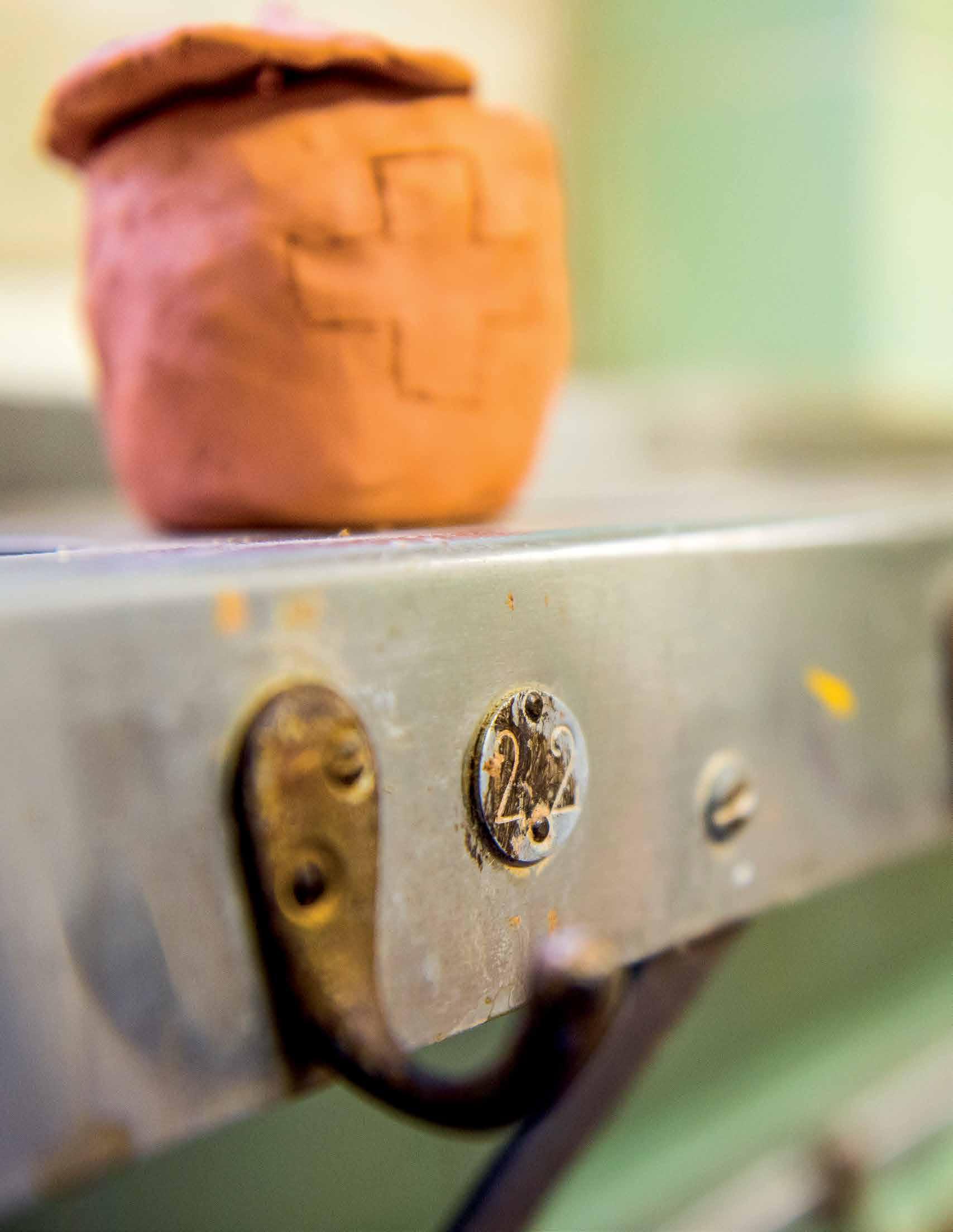
Truth and Reconciliation Commission of Canada
To the children who did not make it home from the residential school system, we honour your memory by telling the truth of these experiences in the hope that it will never happen again and that you will never be forgotten. To the survivors and their families, we acknowledge the cruelty of these experiences and the longterm impact on attendees, their descendants and the community through intergenerational trauma. Bringing these silenced experiences forward is part of the path toward healing: truth first.
The context of this journey is critical and it is only recently that a more collective understanding of the history that continues to shape the historical and lived experiences of Indigenous Peoples has emerged.
The work of the Truth and Reconciliation Commission of Canada (TRC) marked a pivotal shift in public awareness about Indigenous Peoples and histories. With its final report released in 2015, the TRC revealed to Canadians the complex truth about residential schools, documenting the individual and collective harms perpetrated against Indigenous Peoples. The TRC focused on truth telling as a path towards healing for Indigenous Peoples and between Indigenous Peoples and non-Indigenous communities, churches, governments and Canadians generally.
While only a part of our history, the TRC’s difficult work amplifying the voices of residential school survivors offered an opening to a critical discussion about other aspects of the Indigenous colonial experience, including legal dispossession, cultural and linguistic destruction, and restrictions against the right to gather, vote, practice ceremony and attend post-secondary institutions, among many others. It is important to recognize that the pervasive restrictions against Indigenous Peoples, often regarded as historical in nature, persisted and persist, and that the harmful legacy of those measures is still felt to the present day as systemic racism and barriers.
The TRC issued 94 far-ranging Calls to Action urging governments and other entities, including post-secondary institutions, to work together to repair the harm caused by residential schools and to move forward with reconciliation more broadly. Of particular relevance to postsecondary institutions is the legacy of the assimilative practices of the residential

school system on the educational attainment of Indigenous Peoples as well as the challenge to address those.
The TRC noted that universities are uniquely and powerfully positioned to enact reconciliation. The Calls to Action touch on every aspect of the university mandate, with work in teaching, learning, research and community engagement. Reconciliation starts with work across these spaces, asking key questions and looking at the history, policies and practices that shape our current reality in order to tackle systemic racism and dismantle the structures that continue to disadvantage in order to make things right.
“Getting to the truth was hard, but getting to reconciliation will be harder. It requires that the paternalistic and racist foundations of the residential school system be rejected as the basis for an ongoing relationship. Reconciliation requires that a new vision, based on a commitment to mutual respect, be developed. It also requires an understanding that the most harmful impacts of residential schools have been the loss of pride and self-respect of Aboriginal people, and the lack of respect that non-Aboriginal people have been raised to have for their Aboriginal neighbours. Reconciliation is not an Aboriginal problem; it is a Canadian one. Virtually all aspects of Canadian society may need to be reconsidered.”2
Truth
LEFT PHOTO BY JOHN ULAN; RIGHT PHOTO BY RICHARD SIEMENS
24 KUNAKES 25 UNIVERSITY OF ALBERTA INDIGENOUS STRATEGIC PLAN
and Reconciliation Commission of Canada, Honouring the Truth, Reconciling for the Future
United Nations Declaration on the Rights of Indigenous Peoples
The ISP will be a source of guidance and inspiration for our governing bodies at the university. General Faculties Council and the Board of Governors can play a critical role in upholding, advancing and implementing the human rights standards set out in the United Nations Declaration on the Rights of Indigenous Peoples.”
Brad Hamdon General Counsel and University Secretary
The United Nations Declaration on the Rights of Indigenous Peoples (UNDRIP) represents another key political milestone for Indigenous Peoples worldwide.
The product of nearly 25 years of deliberation at the United Nations, the international instrument was supported by Canada in 2016, nine years after its introduction. It was passed by parliament in 2018 and by the Senate in 2021. It recognizes the experiences of Indigenous Peoples with colonialism across the globe, aiming to set minimum standards for the autonomy, health and well-being of Indigenous Peoples. It articulates the need to repudiate doctrines, policies and practices such as the Doctrine of Discovery3 and terra nullius 4 which advocate for the “superiority of peoples or individuals on the basis of national origin or racial, religious, ethnic or cultural differences,” as “racist, scientifically false, legally invalid, morally condemnable and socially unjust.”5 UNDRIP urges an address of the colonial legacy so that Indigenous Peoples might reassert basic human rights. These include the inherent right to selfdetermination; freedom from

UNDRIP is the most comprehensive international instrument on the rights of Indigenous Peoples. It establishes a universal framework of minimum standards for the survival, dignity and well-being of the Indigenous Peoples of the world and it elaborates on existing human rights standards and fundamental freedoms as they apply to the specific situation of Indigenous Peoples.6
United Nations Declaration on the Rights of Indigenous
discrimination; free, prior and informed consent; redress; and linguistic, cultural, spiritual and economic rights. The TRC recommended that federal and provincial governments utilize UNDRIP as a framework for reconciliation, noting that reconciliation encompasses all areas of Canadian life including education.
Peoples (UNDRIP)
27 UNIVERSITY OF ALBERTA INDIGENOUS STRATEGIC PLAN 26 TRESSER LE PASSÉ, LE PRÉSENT ET LE FUTUR
This mixed media sculpture is part of the University of Alberta Museums Art Collection. It shows a parent tying the shoes of a young child. (Artist Unknown; University of Alberta Museums Art Collection; Collected by Milton and Wendy Halvarson; 2019.2.41)
Groundswell
There is a significant expectation from Indigenous and non-Indigenous communities alike that the University of Alberta takes up its role in Indigenous-focused work and reconciliation.
Locally, this theme emerged in the consultations that informed the university’s strategic plan, For the Public Good in 2016. The 2019 Community Engagement Consultations led by External Relations also showed a significant desire for an institutional commitment to Indigenous Initiatives and a response to the TRC Calls to Action. The dialogues for the Indigenous Strategic Plan strongly reiterated these expectations.
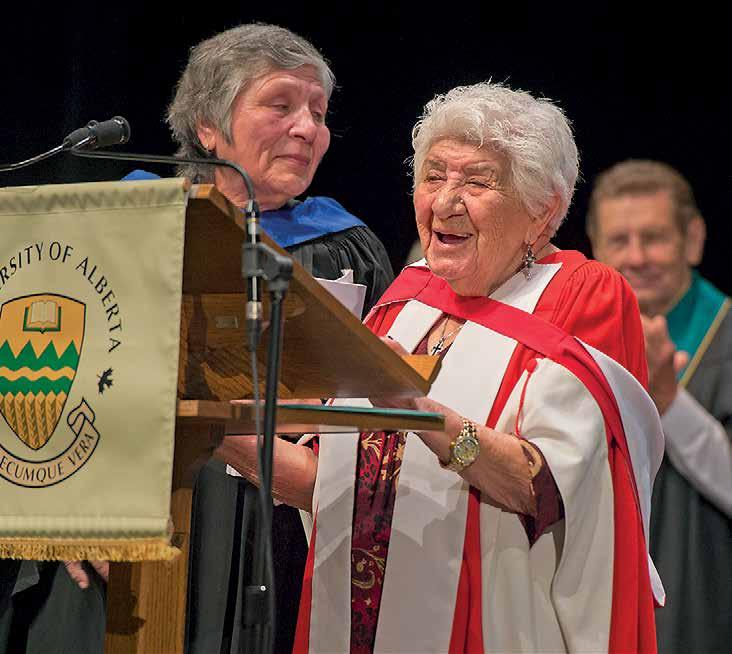

The shifting requirements for Indigenous Initiatives are centred not only in community expectation; universities are facing the imperative of addressing Indigenous initiatives in Indigenousfocused research, teaching and community engagement. These have arisen from post-secondary accreditation bodies, national funding agencies, research council frameworks, professional associations, governments, new requirements for Indigenous-engaged ethical research, and corporate partners requiring robust EDI frameworks.
Within disciplines, those advocating for greater awareness of diverse worldviews, perspectives and silenced narratives cite the value of this work in enriching academic knowledge and
rigour but also in upending the dominant paradigm that centres Eurocentric worldviews, peoples and practices to the exclusion of others. These discourses examine and question the ways that universities have contributed to the harms of colonization and how we might approach structural changes within a decolonization framework.
Critical social justice issues have also emerged as a key policy priority at postsecondary institutions. The themes of marginalization and injustice are at the heart of movements to strengthen the civic role of the institution, ensuring that universities are responsive and work to co-create solutions to the challenges that matter to the public. This shift has influenced how universities are examining key institutional processes including new pedagogical approaches, hiring practices, critical selfreflectivity, community engagement and alignment with government priorities on these themes.
The Supreme Court of Canada affirmed the legal requirement
of the duty to consult with Indigenous Peoples to foster reconciliation.7 The duty to consult requires that governments, corporations and individuals know about and respect Indigenous and treaty rights in order to work with Indigenous nations, governments and communities within the Canadian legal context, also setting a model for broader engagement efforts.
Around the world, and nationally, universities are
being called on to ensure that graduates of their programs are aware that their studies and possible professions are situated on Indigenous lands and have an impact on Indigenous Peoples. In revisiting the foundational understandings in the relationship between Indigenous and nonIndigenous peoples, universities are also providing a space in which to consider what it means to be a good relative in the terms intended in the treaties.
“Too many Canadians know little or nothing about the deep historical roots of these conflicts. This lack of historical knowledge has serious consequences for First Nations, Inuit and Métis peoples and for Canada as a whole. In government circles, it makes for poor public policy decisions. In the public realm, it reinforces racist attitudes and fuels civic distrust between Aboriginal peoples and other Canadians. Too many Canadians still do not know the history of Aboriginal peoples’ contributions to Canada, or understand that by virtue of the historical and modern Treaties negotiated by our government, we are all Treaty people … History plays an important role in reconciliation; to build for the future, Canadians must look to, and learn from, the past.”8
Dr. James Makokis, a family physician, and his mother, Dr. Patricia Makokis, present a lecture on integrated healing. Both are U of A grads.
The late Elsie Yanik, a fourth-generation Métis Elder, accepts her honorary degree from the University of Alberta in 2014.
Truth and Reconciliation Commission of Canada, Honouring the Truth, Reconciling for the Future
28 ᒫᒪᐘᐢᑖ ᓈᐘᐩ , ᒣᒁᐨ , ᐁᑿ ᓃᑳᐣ 29 UNIVERSITY OF ALBERTA INDIGENOUS STRATEGIC PLAN
LEFT PHOTO BY JOHN ULAN; RIGHT PHOTO BY RICHARD SIEMENS
The Indigenous Strategic Plan reflects our hopes and provides a vision and directions to put things into action. Its critical investment in long-term, systemic change assures that generations of the past, present and future will thrive at the University of Alberta, in our homes and in our communities.”
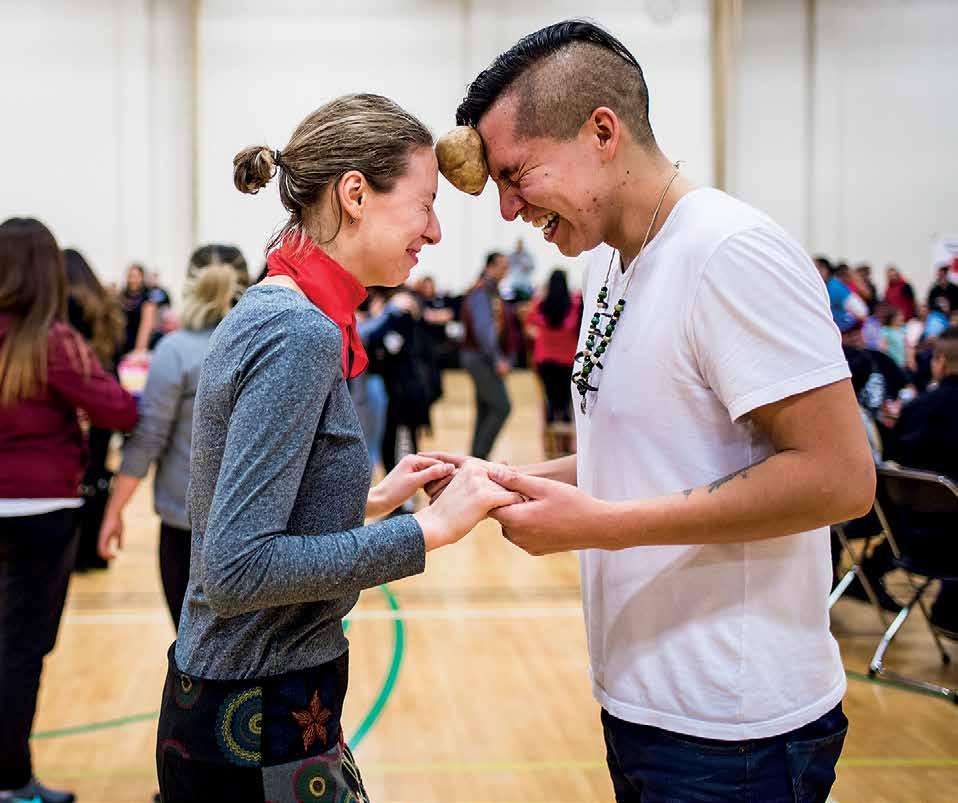
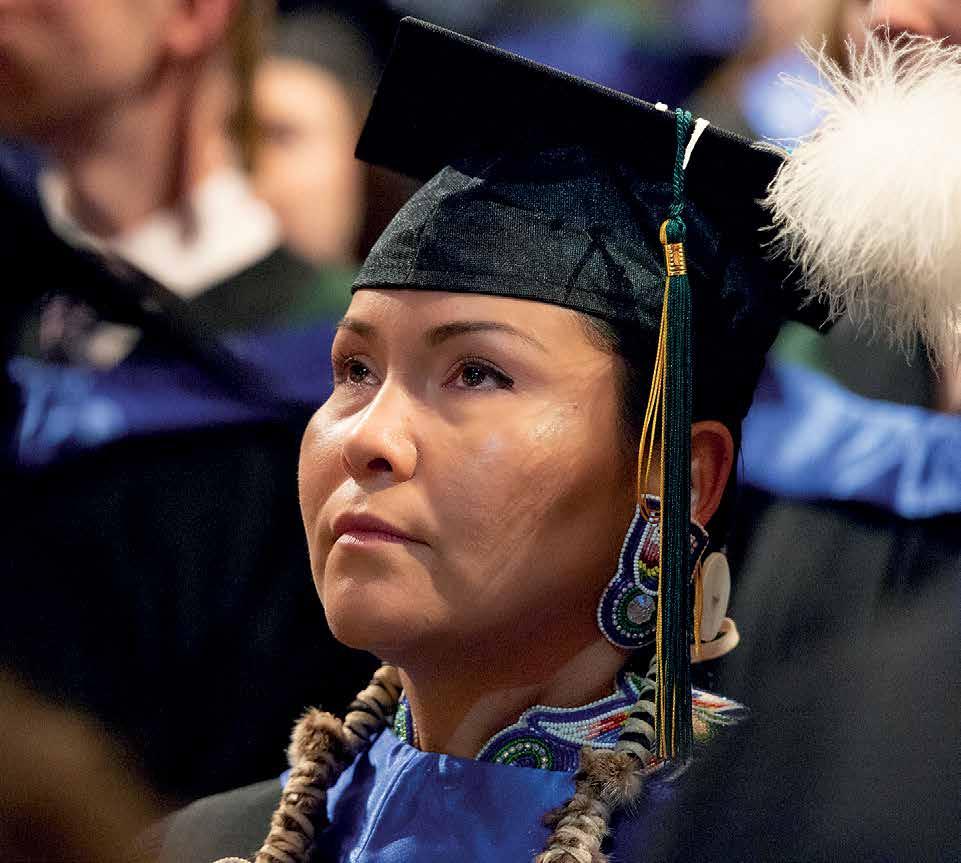


Braiding Past, Present and Future: University of Alberta Indigenous Strategic Plan calls on us to weave Indigenous Ways of Knowing into our work with reverence. We commit to achieving this by collaborating with students, faculty, staff and community members to amplify Indigenous voices, showcase the incredible diversity of the campus community, and honour the traditional territories where the University of Alberta is situated. By communicating broadly the research of Indigenous students and faculty — and by facilitating education that furthers Truth and Reconciliation — we will continue to work towards decolonization both on campus and in the broader community.”
Elan MacDonald Vice President, External Relations
This Indigenous Strategic Plan was undertaken in the most respectful manner possible, with a wide array of constituents and partners, on and off our campuses. The plan itself is comprehensive — operationally and strategically — and offers academic leaders and, indeed, all faculty, staff and students on campus a number of different pathways for fulfilling their responsibilities to the TRC and to working with Indigenous faculty, staff, students, communities and nations in ethical ways. Dr. Glanfield and her team are to be congratulated for their humility and their labour in creating this plan. It is now up to us to carry it out with the same spirit with which it was created.”
Andersen


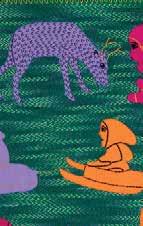
I have been profoundly impacted, both personally and professionally, through various learnings which allow me to better understand the significance and impact of Indigenous history and culture. I affirm our commitment to Indigenize the institution through such actions as adapting our recruitment practices, doing all we can to increase retention of Indigenous employees, ensuring we have policies and practices to build an anti-racism culture, and establishing safe and welcoming spaces. I endeavour to demonstrate the University of Alberta understands we have emerged into a new era that requires different standards and practices.”
Todd Gilchrist Vice President, University Services and Finance
Chief Dr. Robert Joseph, “Healing a Nation Through Truth and Reconciliation,” is my inspiration and the reason I strongly believe in this strategic plan. Dr. Joseph tells us that “when we are reconciled we will live together peacefully and in harmony. When we are reconciled we will be gentle with each other, we will be caring and compassionate. …We will know we are reconciled when every kid knows that they are important, valued, and that they are loved and have a future in our great country.”
Valerie Hunter HR Service Partner, Human Resource Services, Partnerships
Cindy Gaudet
Professeure assistante, Campus Saint Jean
Chris
Dean, Faculty of Native Studies
Dr. Sean Lessard, associate professor in the Faculty of Education, works with students at Maskêkosak Kiskinomâtowikamik school at Enoch Cree Nation.
PAGE
30
31 UNIVERSITY OF ALBERTA INDIGENOUS STRATEGIC PLAN
Participants in the potato dance attempt to dance with the beat during the University of Alberta’s Annual Round Dance. The last couple remaining with the potato still between their foreheads wins — a good omen for their relationship.
LEFT,
TOP AND FOLLOWING
PHOTOS BY JOHN ULAN; BOTTOM RIGHT PHOTO BY RICHARD SIEMENS
OWABI
NEH, DON YACHENE, TAUSUM-GEH YAPKA, NAHA ABA-NEH, TAUDA-BAGE YACEMTE

“Too many Canadians know little or nothing about the deep historical roots of these conflicts.”
33 UNIVERSITY OF ALBERTA INDIGENOUS STRATEGIC PLAN 32 MÂMAWASTÂ NÂWAY, MEKWÂC, EKWA NÎKÂN
Truth and Reconciliation Commission of Canada, Honouring the Truth, Reconciling for the Future
University of Alberta Response
Community Engagement
Seek, build, strengthen, and sustain partnerships with local, national, or international research agencies, governments, government ministries and agencies, univers ities, Indigenous communities, libraries, not-for-profits, industry, business, and community organizations. (Engage, Obj. 18)
Signature Areas
Build a portfolio of signature research and teaching areas where the University of Alberta is or will be recognized as a global leader. (Excel, Obj. 12)
University of Alberta for Tomorrow (2021)
The University of Alberta resides on Treaty 6 territory and the homeland of the Métis. This territory is a traditional gathering place for diverse Indigenous peoples whose histories, languages and cultures continue to influence our community. To acknowledge the territory is to recognize the longer history of these lands. The acknowledgement signifies our commitment to working in Good Relations with First Nations, Métis, and Inuit peoples as we engage in our institutional work, uplifting the whole people, for the university for tomorrow.
Since UNDRIP was passed and the TRC Calls to Action were issued, the University of Alberta has responded by engaging in wide-ranging consultations via its institutional strategic plan, For the Public Good (2016), the Strategic Plan for Equity, Diversity and Inclusivity (2018), University of Alberta for Tomorrow (2021) and the University of Alberta brand (2021).
As directed by these consultations, the university has committed to work on respectful responses to the Calls to Action and reconciliation.
These commitments have begun to find their ways into the university’s academic and administrative practices, with the goal that they will eventually be fully embedded across strategic and unit plans and accountabilities.
To lead and co-ordinate work in Indigenous Initiatives, the University of Alberta sought to create the structures that can carry this work forward. In 2019, the inaugural role of Vice-Provost, Indigenous Programming and Research was established in the Office of the Provost and VicePresident (Academic).
Office of the Vice-Provost, Indigenous Programming and Research
The work of the Vice-Provost, Indigenous Programming and Research Office builds upon and continues the extensive work undertaken across the University of Alberta to assure Indigenous student success, improve the recruitment and retention of Indigenous faculty and staff, and advance key initiatives in alignment with Indigenous community interests. The office will centrally connect Indigenous-related teaching, learning, research and supports to co-ordinate initiatives, share resources, find efficiencies and build capacity.
Diversity
Build a diverse, inclusive community of exceptional undergraduate and graduate students from Edmonton, Alberta, Canada, and the world
Create a faculty renewal program that builds on the strengths of existing faculty and ensures the sustainable development of the U of A’s talented, highly qualified, and diverse academy
Support ongoing recruitment and retention of a highly-skilled, diverse community of non-academic and administrative staff by enriching the U of A’s working environment. Build and strengthen trust, connection, and a sense of belonging among all members of the university community through a focus on shared values.
(Build, Obj. 1-4)
Strategic Plan for Equity, Diversity and Inclusivity (2018)
Commits to Respect for Reconciliation with Indigenous Peoples as a key goal with work to the ISP; equity and capacitybuilding are also outlined as key goals.
University of Alberta Brand (2021)
Working together alongside and in partnership with Indigenous Peoples and all under-represented voices. We weave together a tapestry of backgrounds and cultures, because we are made stronger by our diversity. Together we are change makers, community builders, world shapers. This world has been challenged like never before. But when we stand together and listen to one another, we generate the solutions that make us healthier, safer, stronger and more just.
Calls to Action
Develop a “thoughtful, respectful, meaningful, and sustainable response” to the report of the Truth and Reconciliation Commission of Canada (Build, Obj. 4)
Indigenous Alumni Partner to create and liaise with the Indigenous Alumni Chapter.
Equity, Diversity and Inclusivity
Foster a supportive environment for Indigenous faculty, staff and students.
Representation
Chair the Council on Aboriginal Initiatives
Vice-Provost, Indigenous Programming and Research Mandate (2019)
Aims to support institutional capacity building efforts, equity work and foundational change. The mandate enumerates the following priorities:
Indigenization
Support the work of Faculties and Departments to Indigenize curricula across programs.
Ethical Research Engagement
Develop and implement ethical policies and procedures to guide engagement with Indigenous communities.
Community Engagement
Build and nurture positive relationships with Indigenous communities in Alberta.
Indigenous Strategic Plan
Lead development, consultation, and approval of the Indigenous Strategic Plan in support of the objectives articulated in For the Public Good.
Reconciliation Learning
Foster learning opportunities across our campuses that enable student, staff, and faculty participation in reconciliation.
(Build, Obj. 4, Str. i)
Curricular
Calls upon PSIs to make curricular changes to address the knowledge gap regarding Indigenous histories and contemporary experiences in child welfare, language/ culture, health, justice, media, sports and business as well as a call to create reconciliation research.
(TRC Calls to Action)
Representation
Calls upon PSIs to increase the number of Indigenous professionals in named faculties and beyond. (TRC Calls to Action)
Recruitment, Retention, Completion Calls upon PSIs to eliminate educational and employment gaps for Indigenous peoples as well as to adequately fund (federal government) the backlog of FNMI students seeking post-secondary education. (TRC Calls to Action)
Reconciliation Metrics
Evaluate and measure the university’s response to the TRC’s Calls to Action and ensuring effectiveness on an ongoing basis. (Build, Obj. 4, Str. iii)
Maskwa House
Build the Maskwa House of Learning as a place of welcome and cultural connection, where all Indigenous and non-Indigenous students together can grow and celebrate the unique and proud histories of Indigenous peoples, and where Indigenous students can access the social, cultural, and spiritual supports that enable their success.
(Build, Obj. 4, Str. ii)
For the Public Good (2016)
34 BRAIDING PAST, PRESENT AND FUTURE 35 UNIVERSITY OF ALBERTA INDIGENOUS STRATEGIC PLAN
Dialogues
To begin work on the creation of an Indigenous Strategic Plan, the Office of the Vice-Provost, Indigenous Programming and Research engaged in wide-ranging dialogues, gathering information and listening to community so as to envision the goals, themes and strategies of the plan.
Broad dialogues with University of Alberta leaders in academic, administrative and governance structures took place over the course of two years, and input was solicited from faculties, departments, units and individuals. This included students, faculty and staff. Data sources such as the Workforce Diversity Census and the 2021 Indigenous Student Success Survey were used to frame the dialogues and inform the development of the goals. We are grateful for the diverse contributions to this plan and the work to outline accountabilities and partners for this work in alignment with the feedback from these dialogues.
Indigenous Advisory Council
To ensure an Indigenous-led process to create the Indigenous Strategic Plan (ISP), an Indigenous Advisory Council (IAC) was struck from January 2020 to May 2022. The IAC had 22 First Nations, Métis and Inuit representatives from across employment categories. The council’s mandate was to frame conversations around the ISP’s development; what the indigenization of curriculum and programs might mean; respectful and ethical research with Indigenous Peoples and communities; building supportive and healthy workplace environments for Indigenous faculty, students and staff; and fostering respectful relationships with Indigenous community partners. In gratitude, membership of the Indigenous Advisory Council is listed on pg. 7 of this document.
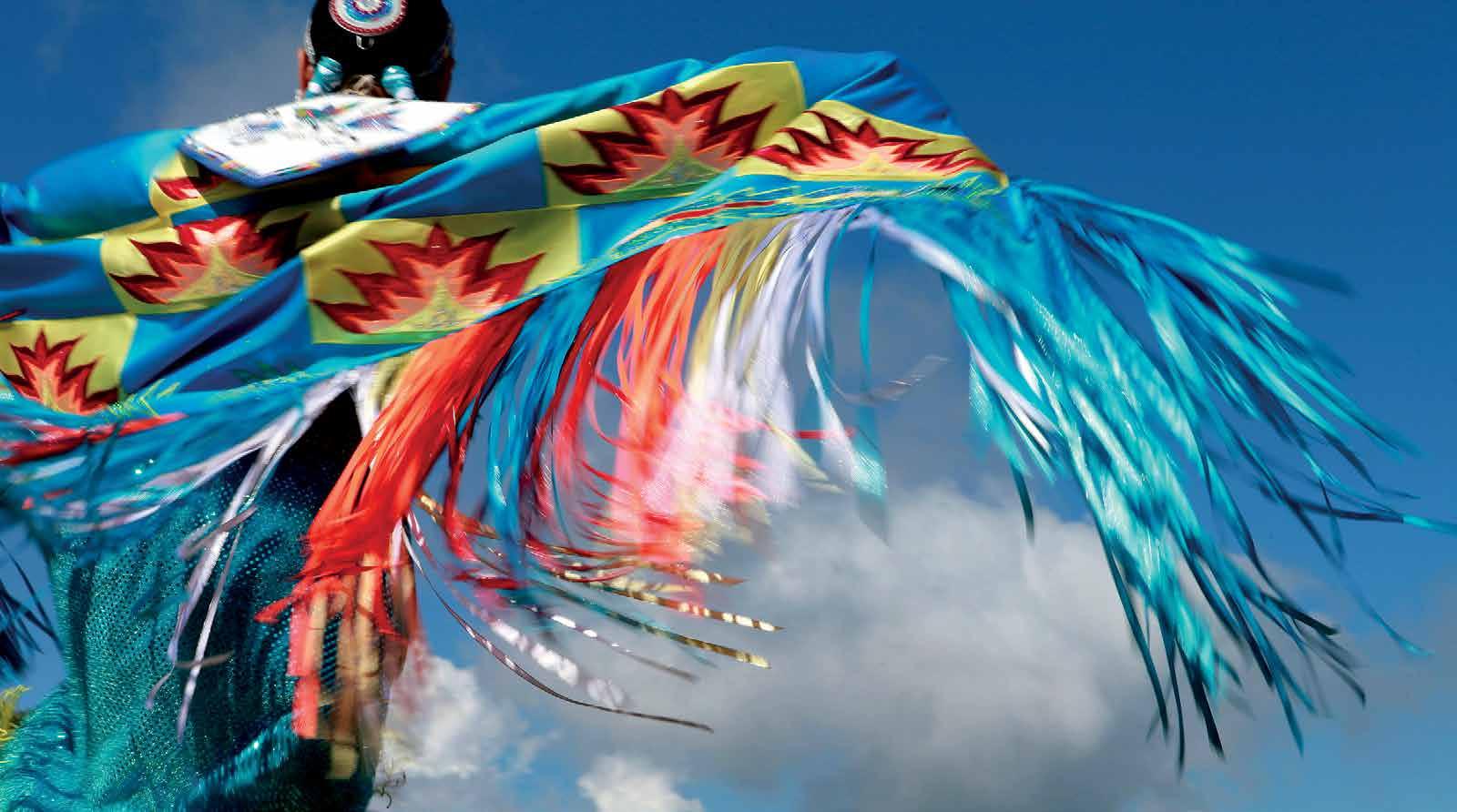
As part of the work to develop the Indigenous Strategic Plan, the Office of the Vice-Provost, Indigenous Programming and Research actively sought direction from the broader internal Indigenous community on the ways in which the university might respectfully and effectively take up the work of Indigenous
Initiatives. The draft and revised Indigenous Strategic Plan was distributed to Indigenous faculty and staff known to the Office of the Vice-Provost, Indigenous Programming and Research for their input and review and the feedback incorporated.
Indigenous Nations and Organizations
The Office of the Vice-Provost, Indigenous Programming and Research met with First Nations, Métis and Inuit nations and organizations across treaty areas and listened to community members, leaders and Elders relate their experiences with the University of Alberta. We learned how they would like to see connections grow between their communities or organizations and the university. The office detailed alignment with these community interests in the strategic plan, imagining pathways for stronger partnerships with community in support of the key objectives they shared. This dialogue, held over a year, was meant to guide the start of the University of Alberta’s work as a Good Relation across a number of priorities and particularly via the Indigenous Strategic Plan.
Indigenous Research Strategies Task Force
The Indigenous Research Strategies Task Force (IRST) was created in December 2020. The goal of the task force is to bring together diverse employees to examine ways that the collective work at the University of Alberta in relation to research ethics, research services, field research and data management can co-ordinate. The aim is to examine work that can be supportive of Indigenous communities, researchers engaged with Indigenous research, data sovereignty, treaty rights and respectful community engagement. The IRST was part of the dialogue
process for the Indigenous Strategic Plan, particularly with those elements aligning specifically with its mandate.
Membership includes:
• Susan Babcock, Director, Research Ethics Office, Vice-President (Research & Innovation) Integrity Support
• Rhonda Bell, Professor, Faculty of Agricultural, Life & Environmental Sciences
• David Bressler, Professor and Associate Dean Research, Faculty of Agricultural, Life & Environmental Sciences; Executive Director, Biomass Energy Network
• James Doiron, Research Data Management Strategies Director, University of Alberta Library; Academic Director, University of Alberta Research Data Centre
• Nadir Erbilgin, Professor and Chair, Faculty of Agricultural, Life & Environmental Sciences
• Florence Glanfield, Vice-Provost, Indigenous Programming and Research; Professor, Faculty of Education
• Geoff Harder, Associate University Librarian, Library and Museums
• Tracey Hillier, Associate Professor, Faculty of Medicine & Dentistry; Co-Director, Situated Knowledges: Indigenous Peoples and Place (SKIPP) Signature Area
• Charmaine Kabatoff, REB Consultant, Research Ethics Office, VicePresident (Research & Innovation) Integrity Support
• Jeffrey Kavanaugh, Associate Professor, Faculty of Science; Director, Field Research Office
• Heidi Robinson, Legal Counsel, VicePresident (Research & Innovation), Research Services Office
• Nella Sajlovic, Indigenous Strategies Manager, Office of the Vice-Provost, Indigenous Programming and Research
• Julie Stephens, Director, Research Partners, Vice-President (Research & Innovation) Research Partners Network
• Kisha Supernant, Associate Professor, Faculty of Arts; Co-Director, Situated Knowledges: Indigenous Peoples and Place (SKIPP) Signature Area; Director, Institute of Prairie and Indigenous Archaeology
• Melissa Tremblay, Assistant Professor, Faculty of Education
• Jessica Vandenberghe, Assistant Dean, Engineering Community and Culture, Faculty of Engineering; President-Elect, Alumni Council
• Nancy Van Styvendale, Associate Professor and Associate Dean Research, Faculty of Native Studies
• Michael Walesiak, Director, Research Administration Services, Vice-President (Research & Innovation)
Members of the IRST who served prior to their resignations from the task force:
• Alex Clark, Professor and Associate VicePresident (Research), Faculty of Nursing
One of my strongest commitments as college dean is to promote a college community that enables an equitable and inclusive society. One that acknowledges history and where equity and diversity are essential to excellence on campus. In consultation with our Indigenous community, we are dedicated to transforming our college by not only encouraging Indigenous perspectives and initiatives into our processes and strategies at every level, but also planning immediate tangible tactics such as curriculum changes, safe spaces for the Indigenous community and the goal of removing barriers to success through collaboration.
We’re proud of our start. From creating dedicated Indigenous office space for students to gather in the Faculty of Arts, to implementing an Introduction to Indigenous Business course in the Alberta School of Business and the commitment to hiring Indigenous professors in all our faculties. But this is only the beginning of what I envision to be a complete transformation of how our college and university operates. We strive to do better and we must do better.”
Joseph Doucet Interim Dean, College
GETTY IMAGES
Jade Tootoosis, Fancy Shawl dancer and Program Co-ordinator in the Faculty of Native Studies
36 PILRARIQ: TAIMANI, HADJA HIVUNIRMILU 37 UNIVERSITY OF ALBERTA INDIGENOUS STRATEGIC PLAN
of Social Sciences and Humanities
Nisitohtamowin (Understanding)
I am so proud of the amazing ideas that went into the ISP. The ISP is so important for the U of A community as a shining example of how Indigenous presence is integral to the betterment of our success and growth across campuses.”
Michelle Durocher Executive Assistant, Corporate
and Foundation Relations
The Indigenous Advisory Council sought an appropriate cultural ethos to communicate to readers the thinking and values that embody Indigenous-focused work at the University of Alberta.
The council selected the Sweetgrass Teachings as this plan’s foundation, noting the personal and professional commitments of the Indigenous people who have shouldered this work in honour of ancestors, loved ones and community. Elder Fernie Marty (Papaschase First Nation) was offered protocol for his guidance and knowledge of the Sweetgrass Teachings for the creation of the Indigenous Strategic Plan.

The shared understandings that the council had of this teaching — of balance, of collective strength, of responsibility to All Our Relations — are at the heart of this cultural ethos. It also signifies the hopes that the council has for the work of the Indigenous Strategic Plan, with a centring of collective responsibility in the pursuit of what is called the Good Life or miyo pimatisiwin in Cree.
Miyo pimatisiwin describes being in harmony — mind, body and soul — with a fulsome wellness and health based on a relationship with cultural identity, others, all things living and the land. The concepts of reciprocity, responsibility, love and care to humans, lands and winged, scaled and the fourlegged inform this plan.
The Sweetgrass Teachings
“Sweetgrass is one of our sacred medicines; it is the hair of Mother Earth. When we gather the sweetgrass we walk gently on Mother Earth, giving thanks for the gifts that she gives — gifts that we need to live a Good Life.
The three strands of the sweetgrass braid have many different meanings for the people but for the teachings I received, they represent the mind, body and spirit. The three need to be in balance for us to have health. The three stands make four as they come together to make the whole, and there is significance to the four.
The four means that we are connected to each other, to the land and to all things living — All Our Relations. We are only one small part of this, us humans, but we are sacred peoples and we are meant to be gentle with each other and all of our relations.
The sweetgrass helps to remind us of this — of our sacred nature and our connection to the land. It also reminds us that we must pray for guidance from the Creator. When we smudge with sweetgrass, we humbly ask the Creator to bring good energy to us, to purify us, to move the negative energies away from us to protect our minds, our bodies, our spirits and where we live.
We ask that the Creator bring us clean thoughts, a clean body and a clean spirit. We ask that we remain humble and open to being guided to the lessons that are all around us if our hearts are open. This is important because we can be pulled away from what is good to bad things like
anger and hate. There is so much pain in the world. The pain causes the anger and hate. The sweetgrass reminds us to be in tune with goodness so that we can live a good life.
When we do this it also allows others to see who we are as people, and our goodness is an example of what is the right way to live. We are a gentle people. There is medicine in remembering that we are gentle. There is medicine in laughter. Our people like to laugh. Laughter brings healing. Laughter helps to remind us that no one is perfect; we are all just learning.
When we braid our hair, we pray. We think of the ones that came before us and of the Creator, asking them to shield us from bad things. We know that our ancestors see us and watch over us even though they are not with us in the here and now.
When we braid, we honour the ones that came before us and we take time to ask the Creator and them for help to live a good life. In this way, our braids are a way to care for the loved ones in front of us and to honour the ones who came before us. It [braiding] helps us to think on the things that make a good life. We do this in prayer. We say thanks for the gifts of the earth and we remember to care for each other and those gifts.”
I see the ISP as a difficult but necessary road map on the journey to true Reconciliation.”
Gil Anderson
Academic Services Co ordinator, Masters and Professional Programs Office, Alberta School of Business
Elder Fernie Marty shares the Sweetgrass Teachings, which embody the values of this plan
as shared by Elder Fernie Marty
39 UNIVERSITY OF
INDIGENOUS STRATEGIC PLAN 38 APPOTSIPIISTOP KIPAITAPIIYSSINNOON
PHOTO BY ARSAN BUFFIN
ALBERTA
Braiding Past, Present and Future: University of Alberta Indigenous Strategic Plan
This five-year plan is the University of Alberta’s first formally endorsed Indigenous Strategic Plan and responds to the themes that emerged in dialogue by articulating specific goals, strategies and timelines.
The plan is grouped into three categories, or “strands,” symbolizing the responsibilities of the Sweetgrass Teachings: Looking to the Past, In-Powering1 the Present and Imagining the Future. These three groupings represent a sweetgrass braid and the accompanying prairie- and parkland-based Indigenous understandings, to reflect where the University of Alberta is primarily — though not only — located.
In many Indigenous cultures, the braid also represents mind, body and spirit and the balance needed among the three for good health and harmony in individuals and communities. It represents understandings about the relationality of all peoples and to all things living.

The braid was also selected as a reminder of the beauty, pride and resilience of Indigenous Peoples. The loss of braided hair is linked in communal memory to the trauma of colonialism and its assimilative practices.
As the resurgence of Indigenous Peoples continues, the braid has become a symbol of defiance and identity assertion and also
1 The modified word “In-Powering” was chosen deliberately to indicate that the skills and strengths needed for individual and collective success already reside in Indigenous peoples and communities. This strengths-based lens acknowledges that the focus of this work should be on removing structural barriers.
represents that the past, present and future are intertwined.
This symbolism indicates that this strategic plan is a living document that will evolve as this work progresses. Within the context of this plan, the braiding of past, present and future is a commitment to restoring balance and wellness.
The content laid out in this document is a prioritization of the broad work of Indigenous Initiatives. Acknowledging that the breadth of the themes and strategies detailed in this plan require extensive institutional collaboration, this document aims to imagine the ways in which Indigenous-focused work might be built into institutional accountabilities and embedded into diverse structures, processes and roles. The goal is to create institutionwide responsibility to deliver on the outlined goals.
Braiding Past, Present and Future: University of Alberta Indigenous Strategic Plan reflects an important step in our institution’s commitment to reconciliation in postsecondary education and research and to addressing the historical legacy of the residential school system and Canada’s colonial history in a meaningful and lasting way.
40 ĪTS’ĪT
41 UNIVERSITY OF ALBERTA INDIGENOUS STRATEGIC PLAN
PHOTO BY JOHN ULAN
ⱢÚNĪ WÚNÀDÍ, DĀ-HĪ, WÚSĀ
Where We Are in the Journey
Decolonial Indigenization
Envisions the wholesale overhaul of the academy to fundamentally reorient knowledge production based on balancing power relations between Indigenous peoples and Canadians, transforming the academy into something dynamic and new.
Reconciliation Indigenization

It has been seven years since the final report of the Truth and Reconciliation Commission of Canada was released. The University of Alberta acknowledges that it is only at the beginning of this complex, generational work.
Universities across Canada have responded to the Truth and Reconciliation Commission’s 94 Calls to Action in ways relevant to their institutional context. Throughout Canada, this work is still largely at its inception.
Indigenous knowledge holders tell us that life and living is a cyclical and recursive journey. At the start of each new day, we have the wisdom from the days past to feed into that day’s journey, and as the day passes, we have an opportunity for new learnings that shape and change what we already know. In the same way, the institutional work of implementing Braiding Past, Present and Future will also be a recursive journey. We will build upon previous exposures, successes and lessons, sometimes appearing to go backwards, pausing and moving forward again with newly integrated understandings. Recursion is much more complex than repetition. Indigenous teachings about
humility in learning offer an understanding to this — we, individually and collectively, are all on a journey of lifelong learning.

In examining how universities have responded to reconciliation, University of Alberta scholars Adam Gaudry and Danielle Lorenz developed an evaluation framework to characterize this work. The strategies included in Braiding Past, Present and Future are intended to move the university along the path they described,9 from Inclusion Indigenization to a fulsome integration of Indigenous understandings: Decolonial Indigenization.
Through the dialogues, we know that in some spaces at the University of Alberta, we are at the beginning of this path, increasing Indigenous representation and presence. In others, work has progressed to examining ways in which the university itself might engage in critical self-reflection


to disrupt the colonial structures and practices that result in exclusion. The goal of this strategic plan is to move forward with the TRC’s full conceptualization of the work of truth and reconciliation: to upend the intellectual underpinnings of colonial marginalization.
A key theme that emerged in the dialogues for this plan was the need for metrics to benchmark where the University of Alberta is at with respect to fulfilling its committments to the TRC Calls to Action and Indigenous Initiatives more broadly. Work to collect information on progress, to document gains
and to identify challenges will inform next steps for this plan including the development of a reporting mechanism for the outlined goals and strategies. Aligned to this work is a TRC Report to Community, mandated by For the Public Good which will specifically measure the institutional work on the Calls to Action, serving as a baseline for Indigenousfocused work. The goals and strategies in Braiding Past, Present and Future have been designed in such a way that the accountabilities are built across diverse portfolios and units and this adds additional layers of reporting and accountability as a practice as well.
A vision that locates indigenization on common ground between Indigenous and Canadian ideals, creating a new, broader consensus on debates such as what counts as knowledge, how should Indigenous knowledges and Europeanderived knowledges be reconciled, and what types of relationships academic institutions should have with Indigenous communities.
Indigenous Inclusion
A policy that aims to increase the number of Indigenous students, faculty and staff in the Canadian academy. Consequently, it does so largely by supporting the adaption of Indigenous people to the current (often alienating) culture of the Canadian academy.
As chancellor and on behalf of the University of Alberta Senate, I affirm our strong support for the U of A’s Indigenous Strategic Plan (ISP). Since I became chancellor, I have learned so much not only about our country’s past, our history of injustices to Indigenous Peoples and the impact that continues to have on Indigenous Peoples today, but also about their vibrant cultures and Indigenous Ways of Knowing. Guided by Dr. Florence Glanfield, Shana Dion and others at the U of A, my understanding has grown dramatically and, for that, I am deeply grateful. Our Senate is proud of work we did in the past that led to the establishment of the Faculty of Native Studies,
but there is so much more work to be done. That’s why Indigenous Initiatives are now one of the three priorities identified in the Senate’s new strategic plan. Our actions will champion the ISP in any way we can, increase opportunities for Indigenous children to participate in the Senate’s U School program, grow Indigenous representation on Senate, and support the ongoing work of the university in opening its doors to more and more Indigenous students. The plans are now in place, and we’re only just beginning.”
Peggy Garritty Chancellor
42 KUNAKES 43 UNIVERSITY OF ALBERTA INDIGENOUS STRATEGIC PLAN PHOTO BY SEAN BUCHANAN
My hope for this strategy is to lay the groundwork for future generations of students and staff to live and work as a connected community — wahkohtowin It recognizes that we have two very different cultures that want to walk together in a Good Way. The success of the Indigenous Strategic Plan will depend on strong communication, openness and, most importantly, trust. The strategy is not just for our children but also for those not yet born, seven generations and into the future.”
Ceilidh Morrissette Research Co ordinator, Faculty of Arts, Humanities Administrative Services

The University of Alberta’s vision is to illuminate our world-leading Indigenous-led and Indigenous-engaged research and practices, providing leadership in Indigenous scholarship, research and community engagement.”
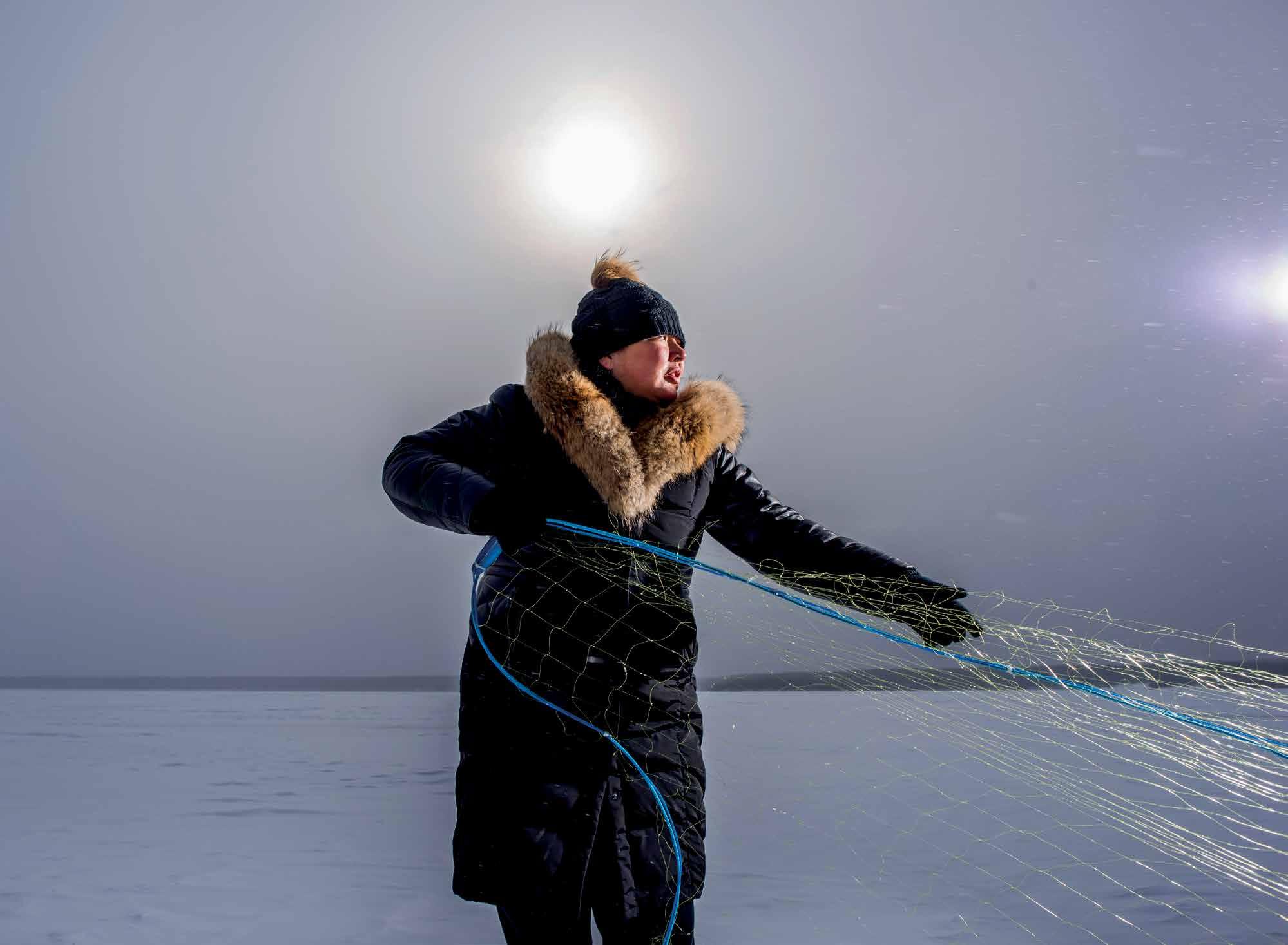 Aminah Robinson Fayek Vice President, Research and Innovation
Aminah Robinson Fayek Vice President, Research and Innovation
The Indigenous Strategic Plan does more than generate policy towards decolonial indigenization. It is a centre point and meeting place for our Indigenous faculty and staff at the University of Alberta. Colonialism has done much to diminish and get in the way of our relations — with each other and with the Land. The ISP is another way we resist this dispossession, helping us come together and reminding the university institution that we are on Indigenous, relational territory.”
 Paul Gareau Assistant Professor, Faculty of Native Studies
Janice Makokis, a legal scholar and U of A grad from Saddle Lake Cree Nation, at the Kikino Métis Settlement.
Paul Gareau Assistant Professor, Faculty of Native Studies
Janice Makokis, a legal scholar and U of A grad from Saddle Lake Cree Nation, at the Kikino Métis Settlement.
TOP LEFT AND RIGHT PHOTOS BY JOHN ULAN; BOTTOM LEFT PHOTO BY RICHARD SIEMENS 44 PILRARIQ: TAIMANI, HADJA HIVUNIRMILU 45 UNIVERSITY OF ALBERTA INDIGENOUS STRATEGIC PLAN
Truth and Reconciliation Commission of Canada, Honouring the Truth, Reconciling for the Future
“This painting represents the connection of my grandmother, mother and me, as I needed to see them — blanketed by love, security and strength in spite of the trauma of residential schools,” says Lana Whiskeyjack of her 2015 painting Exploring Intergenerational Trauma Series, No. 1. Used with permission.

“Getting to the truth was hard, but getting to reconciliation will be harder.”
46 MÂMAWASTÂ NÂWAY, MEKWÂC, EKWA NÎKÂN 47 UNIVERSITY OF ALBERTA INDIGENOUS STRATEGIC PLAN
Themes, Goals and Strategies
Accountabilities
The named accountabilities listed for each of the strategies are not exhaustive and instead denote those most responsible (collectively) for beginning the work described. The accountabilities are listed alphabetically and not by order of precedence. Other leaders or units may also have work to contribute to the named strategies.
The Braid
The strategies outlined in this plan have been organized into three categories: Looking to the Past, In-Powering the Present and Imagining the Future. This approach symbolizes the responsibilities of the Sweetgrass Teachings (page 39) and represents the shared understandings that the council had of this teaching: balance, collective strength and responsibility to All Our Relations. These are at the heart of this cultural ethos and of this plan.
GOALS STRATEGIES ACCOUNTABILITIES
10.0 Indigenous faculty and staff: recruitment and retention
The University of Alberta is recognized as an employer of choice for Indigenous faculty and staff
10.1 Convene a working group to review and advise on relevant policies and procedures for the recruitment and retention of Indigenous faculty and staff, identifying challenges and opportunities
10.2 Identify and implement mechanisms to support equity processes and procedures for hiring and retaining Indigenous faculty and staff
10.3 Create a dedicated Indigenous human resources advisory position and a network of individuals to provide expertise in Indigenous hiring and retention practices
Acronyms
The following is a list of acronyms used in the charts:
VPA Vice-President (Academic)
VP&DOS Vice-Provost and Dean of Students
VPER Vice-President (External Relations)
VPFGSR Vice-Provost and Dean (Faculty of Graduate Studies and Research)
VPF&O Vice-President (Facilities and Operations)
VPIPR Vice-Provost (Indigenous Programming and Research)
VPP Vice-Provost (Programs)
VPLI Vice-Provost (Learning Initiatives)
VPL&M Vice-Provost, Library and Museums
VP® Vice-Provost and Registrar
VPRI Vice-President (Research and Innovation)
VP&AVPUAI Vice-Provost and Associate Vice-President (International)
VPUS&F Vice-President, University Services and Finance
Looking to the Past
1.0 Indigenous leadership and co-ordination
2.0 Accountability and reporting
3.0 Indigenous Ways of Knowing: programs
4.0. Relationship with Indigenous lands and nations
5.0 Indigenous-centred policy, protocol and praxis
6.0 Reconciliation research and scholarship
7.0 University of Alberta community participation in reconciliation
College Deans, Deans, VPUS&F
In-Powering the Present
College Deans, Deans, VPUS&F
VPUS&F
Timeline
The five-year timeline noted in the charts and the associated dots communicate when work will begin on the strategies (and not completion targets). The years noted are aligned to the academic calendar year.
8.0 Indigenous students: recruitment, retention and completion
9.0 Indigenous student attainment: tackling barriers
10.0 Indigenous faculty and staff: recruitment and retention
11.0 Safe and welcoming spaces
Imagining the Future
12.0 Ethical research with Indigenous nations, peoples and lands
13.0 Indigenous-led research capacity development
14.0 Indigenous community engagement: nations, organizations and peoples
15.0 Indigenous community-engaged research
16.0 Indigenous community engagement: University of Alberta Senate
17.0 Indigenous community engagement: University of Alberta Alumni
18.0 Innovative funding
2022-23 2023-24 2024-25 2025-26 2026-27
l
l
l
49 UNIVERSITY OF ALBERTA INDIGENOUS STRATEGIC PLAN 48 TRESSER LE PASSÉ, LE PRÉSENT ET LE FUTUR
Tom Hunter, a member of Saddle Lake Cree Nation, is a collections assistant at the U of A Museums who helps to preserve art and history as part of his role. He came to the university more than 25 years ago as part of a partnership between the academy, the Métis Nation of Alberta and the federal government.

Looking to the Past
The first grouping of goals focuses on the “remedial” actions outlined by the Calls to Action issued by the Truth and Reconciliation Commission of Canada (TRC) and broader indigenization efforts. This grouping aims to remediate the erasure and exclusion of Indigenous knowledges, histories and knowledge systems. The work recognizes the gaps in traditional western higher education and also the harm that those gaps have had on the lived experiences of Indigenous Peoples. Implicit in this work is the acknowledgment that the university participated, and participates, in aspects of colonialism that were, and are, deeply harmful to Indigenous Peoples and that there is a wrong to right. The same power that was employed to disenfranchise Indigenous Peoples can now be brought to bear on the education of the students we serve and those beyond the institution.
GOALS STRATEGIES
1.0 Indigenous leadership and co-ordination
Centrally connect Indigenous-related teaching, learning, research and supports to ensure adequate resourcing, to better co-ordinate, to ensure Indigenous initiatives are Indigenous-led and that there is broad institutional accountability for this work
1.1 Hire an additional person in the Office of the Provost and Vice-President (Academic) to support the implementation of the Indigenous Strategic Plan (ISP)
1.2 Establish the Indigenous Advisory Council (IAC) as a group that can offer wisdom and guidance on actions taken by colleges, faculties and units in relation to goals in the ISP and Indigenous engagement
1.3 Create an Indigenous Wisdom Council of external Indigenous Knowledge Holders to assist with high-level, Indigenous-focused advice and decision-making
1.4 Map joint areas of responsibility across the University of Alberta to guide collaboration and share accountability for Indigenous Initiatives, including supporting the project or committee-based delegation of Indigenous staff to Indigenous-focused institutional work
1.5 Create structures within colleges, faculties and units, led or co-led by an Indigenous person, to develop college, faculty and unit actions to achieve the goals outlined in the Indigenous Strategic Plan
ACCOUNTABILITIES
VPA l
VPIPR l
President, VPIPR l
All, VPIPR l
College Deans, Deans, VPA, VPER, VPF&O, VPRI, VPUS&F l
2022-23 2023-24 2024-25 2025-26 2026-27
PHOTO
ULAN 50 YANISĮ DUHŲ CHU YANATHE ATŁAGHETŁ’Ų
BY JOHN
51 UNIVERSITY OF ALBERTA INDIGENOUS STRATEGIC PLAN
4.0 Relationship with Indigenous lands and nations
GOALS STRATEGIES ACCOUNTABILITIES
2.0 Accountability and reporting
Include Indigenous knowledge systems, experiences and perspectives in all undergraduate, graduate and continuing professional education programs via new course and new program approval and quality assurance processes
2.1 Publish a TRC Report to Community every two years to evaluate, report and act on institutional, faculty and unit responses to the TRC Calls to Action
2.2 Include goals in alignment with the Indigenous Strategic Plan in unit-level strategic plans
2.3 Ensure that all leadership category reviews include reporting on activities related to the Indigenous Strategic Plan
2.4 Gather and co-ordinate data to track progress on achieving goals in the Indigenous Strategic Plan for internal and external reporting
2.5 Utilize the college structures of Associate Dean (Education), Associate Dean (Research), and the Strategic Initiatives office to collaborate and implement strategies to support the goals outlined in the Indigenous Strategic Plan
2.6 Establish an Indigenous Strategic Plan implementation team, chaired by the VPIPR
3.0 Indigenous Ways of Knowing: programs
Weave Indigenous worldviews, histories and perspectives into all undergraduate, graduate and continuing professional education programs, recognizing the validity of Indigenous knowledge systems, remediating the knowledge gap on Indigenous historical and lived experiences, and strengthening academic rigour across disciplines
3.1 Include Indigenous knowledge systems, experiences and perspectives in all undergraduate, graduate and continuing professional education programs via new course and new program approval and quality assurance processes
3.2 Develop financial, administrative, leadership and mentorship processes to achieve the goal
3.3 Create resources and workshops for faculty to illuminate the institutional spaces in which the Indigenous curricular gap/Indigenous Ways of Knowing might be integrated into course materials; promote existing fieldspecific literature to support this work
3.4 Establish institutional partnerships and relationships with Indigenous organizations and communities in support of Indigenous language revitalization, respecting that Indigenous communities have sovereignty over their languages
College Deans, Deans, VPER, VPF&O, VPIPR, VPRI, VPUS&F
College Deans, Deans, Department Chairs, VPER, VPF&O, VPRI, VPUS&F
President, VPA, VPER, VPF&O, VPRI, VPUS&F l
All, VPIPR
College Deans
Utilize university infrastructure (physical, web and communications) to acknowledge the foundational nature of Canada’s relationships with diverse Indigenous nations, the First Peoples of the places that the University of Alberta currently manages, and to create safe and welcoming spaces for all
4.1 Incorporate the visibility of Indigenous territory, including Indigenous Peoples in consultation for land use and space design and considering what it would mean to regard land as a relation. This is meant to acknowledge the long history of our campuses as sites of Indigenous habitation, gathering and sacred significance, not as terra nullius
4.2 Develop the necessary policies to support the use of university infrastructure for internal and external Indigenous community-building and gathering purposes and ceremony
4.3 Increase the digital and communications-based visibility of Indigenous presence at the university
4.4 Incorporate the Territorial Acknowledgments on the U of A main page and in all public addresses and written statements
5.0 Indigenous-centred policy, protocol and praxis
Examine and revise university policy and protocol to support respectful Indigenous inclusion
5.1 Revise and create new university policies to support and celebrate Indigenous inclusion, respectfully facilitate connections between the university and Indigenous communities, and bridge university/legal practices with Indigenous-centred protocols and Indigenous identity
VPER, VPF&O, VPIPR
President, VPA, VPER, VPF&O, VPRI, VPUS&F l
5.2 Document and share appropriate cultural protocols for connecting with Elders, Knowledge Keepers and other Indigenous community members
VPF&O, VPIPR l
VPER l
VPER l
VPER, VPF&O, VPIPR, VPRI, VPUS&F
College Deans, Deans, VPIPIR, VPLI, VPP l
College Deans, Deans, VPA, VPUS&F l
VPLI, VPIPR l
College Deans, Deans, VPIPR l
3.5 Develop relevant Indigenous-focused programming for international students VPIPR, VPLI, VP&AVPUAI l
5.3 Identify and remediate challenges with appropriate remuneration (honoraria) and culturally appropriate gifts within the university context
5.4 Align Indigenous-focused policy work with revisions of the Equity, Diversity and Inclusivity (EDI) plan and implementation
6.0 Reconciliation research and scholarship
Work with relevant partners to advance, fund and showcase reconciliation, indigenization and decolonization research and scholarship
VPIPR l
VPIPR, VPRI, VPUS&F l
VPIPR l
6.1 Work with government entities to create a national research program with multi-year funding to advance an understanding of reconciliation
6.2 Showcase the scholarship of U of A faculty members engaged in examining reconciliation or advancing aspects that increase historical and contemporary understandings of Indigenous Peoples, knowledge systems, nations, communities and lands
6.3 Pursue mechanisms to fund reconciliation research
VPER, VPRI
VPER, VPRI
VPER, VPRI l
6.4 Create a TRC-focused endowed chair VPER, VPRI
2022-23 2023-24 2024-25 2025-26 2026-27
GOALS STRATEGIES ACCOUNTABILITIES
l
l
l
l
l
2022-23 2023-24 2024-25 2025-26 2026-27
l
l
l
l
l
Looking to the Past (continued) 53 UNIVERSITY OF ALBERTA INDIGENOUS STRATEGIC PLAN 52 APPOTSIPIISTOP KIPAITAPIIYSSINNOON
The Indigenous Strategic Plan outlines critical opportunities for reconciliation throughout our institution and requires action from the full University of Alberta community. We need to prioritize and increase our capacity for Indigenous-focused initiatives, such as curricular changes, so that we continue to work towards teaching, learning, researching and working together in good relations at the U of A. I’m committed to supporting Indigenous leadership on campus, and I am proud to play a role in bringing the plan to life.”
Steven Dew
Provost and Vice‑President, Academic
GOALS STRATEGIES ACCOUNTABILITIES
7.0 University of Alberta community participation in reconciliation
Foster learning opportunities that enable all students, staff, faculty members and alumni to participate in reconciliation
7.1 Promote the Indigenous Canada: Looking Forward, Looking Back Massive Open Online Course (MOOC/miniMOOC), including offering faculty and staff work time to complete the course, and utilize other developed courses such as the anti-Indigenous racism module to support this work
7.2 Create a primer on the Indigenous Peoples of Alberta, including the different nations, cultural and linguistic differences, governance structures, geographical territories, treaty relationships and nontreaty relationships to address the knowledge gap
7.3 Create and offer free courses, workshops, events and other resources to students, staff, faculty and alumni (during work hours for employees) to tackle the knowledge gap around racism, historical and contemporary Indigenous experiences and the foundational agreements
7.4 Partner with external entities, such as libraries, municipalities and public schools, to build capacity for TRC teachings within a larger collaborative system so that opportunities for learning can be taken up
7.5 Create programs that showcase the university’s Indigenous cultural, archeological and artistic objects
7.6 Strengthen the partnership with the National Centre for Truth and Reconciliation to permanently preserve the memory of Canada’s residential school system
7.7 Support activities and events to acknowledge and commemorate the victims and survivors of the residential school system
VPER, VPUS&F
Using ground-penetrating radar, Dr. Kisha Supernant, director of the Institute of Prairie and Indigenous Archaeology, works with Indigenous communities to locate the unmarked graves of residential school children who didn’t come home.

VPER, VPIPR, VPRI
VPER, VPIPR, VPLI, VPUS&F
VPER, VPIPR
VPER, VPIPR, VPL&M l
VPA, VPIPR l
Chancellor, President, VPER, VPIPR l
Looking to the Past (continued)
2022-23 2023-24 2024-25 2025-26 2026-27
l
l
l
l
54
55 UNIVERSITY OF ALBERTA INDIGENOUS STRATEGIC PLAN
PHOTO BY JOHN ULAN
AHPIKAHTEYKIN MEY’OOSNZAH, NOONGKOM SIKWA OOTIH NIIGKAN
In-Powering the Present
The second grouping of goals focuses on actions that support the recruitment and retention of a diverse group of students, faculty and staff. This work acknowledges the urgent need to address the systemic barriers that limit full Indigenous participation in the offerings of the university — barriers that have artificially prevented Indigenous Peoples from greater individual and collective sovereignty.
GOALS STRATEGIES ACCOUNTABILITIES
8.0 Indigenous students: recruitment, retention and completion
Graduation rates at the University of Alberta exceed the provincial proportion of Indigenous Peoples
8.1 Support the Indigenous Recruiter Circle in developing wise undergraduate student recruitment and retention practices that make the University of Alberta a destination of choice

8.2 Convene a group to review, update, track and report on Indigenous graduate student recruitment and retention practices to develop and implement a recruitment and retention strategy that makes the University of Alberta a destination of choice
8.3 Establish new and expand current innovative methods of relationship building and early learning engagement with Indigenous students (e.g., USchool, DiscoverE) in Grades K-9
8.4 Establish innovative pathways to support the entry of Indigenous students in Grades 7-12 into programs with low rates of Indigenous participation
8.5 Indigenize, and expand, undergraduate student recruitment practices to make the University of Alberta a destination of choice
8.6 Utilize data from the Indigenous Student Success Survey to support recruitment and retention
8.7 Develop strategies to support students from remote Indigenous communities, acknowledging that those students may require differing types and levels of support to achieve success
8.8 Expand the online delivery of programs and courses in order to connect with mature and underserved Indigenous learners
VP&DOS, VP®
VPFGSR
Chancellor, VP&DOS, VP®, VPIPR l
Chancellor, VP&DOS, VP®, VPIPR l
VP® l
VP&DOS, VP®, VPFGSR l
VP&DOS, VP® l
VPA
2022-23 2023-24 2024-25 2025-26 2026-27
l
l
l
PHOTO BY JEANETTE SESAY 56 TRESSER LE PASSÉ, LE PRÉSENT ET LE FUTUR 57 UNIVERSITY OF ALBERTA INDIGENOUS STRATEGIC PLAN
In-Powering the Present (continued)
As Alberta’s pre-eminent teaching and research institution, the University of Alberta has a responsibility to participate in reconciliation by incorporating Indigenous worldviews in its curriculum, providing opportunities for Indigenous community-engaged research, and ensuring our campuses are welcoming to, and truly inclusive of, Indigenous students, faculty, staff and communities. The Board of Governors and its committees will therefore support and uphold the ISP to ensure adequate focus and progress.”
Kate Chisholm Chair, Board of Governors
11.0 Safe and welcoming spaces
GOALS STRATEGIES ACCOUNTABILITIES
9.0 Indigenous student attainment: tackling barriers
Develop strategies to remove financial and other barriers to full Indigenous student participation in the offerings of the university
9.1 Identify and advocate for new funding opportunities for Indigenous students with government funders, corporate sponsors and individual donors, partnering with relevant university units
9.2 Promote student awareness of existing financial supports and provide assistance in the funding application process
10.0 Indigenous faculty and staff: recruitment and retention
The University of Alberta is recognized as an employer of choice for Indigenous faculty and staff
10.1 Convene a working group to review and advise on relevant policies and procedures for the recruitment and retention of Indigenous faculty and staff, identifying challenges and opportunities
10.2 Identify and implement mechanisms to support equity processes and procedures for hiring and retaining Indigenous faculty and staff
10.3 Create a dedicated Indigenous human resources advisory position and a network of individuals to provide expertise in Indigenous hiring and retention practices
10.4 Engage with Association of Academic Staff of the University of Alberta (AASUA) and Non-Academic Staff Association (NASA) to build policies that support Indigenous-focused hiring and retention equity processes
10.5 Track and report on Indigenous faculty and staff hiring and retention, utilizing the institutional census as a possible tracking mechanism
10.6 Establish an Indigenous mentorship program for Indigenous faculty and staff to increase institutional capacity in Indigenous leadership
10.7 Ensure the availability of Indigenous counsellors via the Employee and Family Assistance Program (EFAP)
VP&DOS, VP®, VPFGSR l
Create safe and welcoming physical and virtual spaces for First Nations, Inuit and Métis students, faculty, staff and community members
It has been my pleasure to be an active listener in the creation of the U of A’s Indigenous Strategic Plan. This plan will serve as the foundation to strengthen the university’s focus on Indigenous communities and partners. As vicepresident, I affirm Facilities and Operations’ commitment to acknowledging Indigenous voices and culture and, wherever possible, endeavour to incorporate and acknowledge these perspectives through our physical infrastructure.”
Andrew Sharman Vice President, Facilities and Operations
College Deans, Deans, VPUS&F l
College Deans, Deans, VPUS&F l
VPUS&F l
VPUS&F l
VPIPR, VPUS&F l
VPIPR, VPUS&F l
VPUS&F l
11.1 Create and offer anti-racism and cultural sensitivity training in partnership with relevant units for all U of A faculty, staff and students
11.2 Review University of Alberta policies, practices and governance mechanisms for addressing institutional and individual racism
11.3 Build Indigenous virtual and in-person networks as a community-building exercise and in acknowledgment of the fact that, due to colonial trauma, universities are often the first safe place in which some Indigenous individuals are able to explore identity and reconnect with community
11.4 Support the First Peoples’ House Round Dance, promoting participation by the wider community (internal and external) and co-ordinating the participation of multiple units in this event
11.5 Develop an Indigenous Initiatives Communications Strategy that increases the visibility of Indigenous Peoples and appropriate representations of Indigenous presence
11.6 Ensure Indigenous Initiatives are included as part of faculty, staff and student orientations
11.7 Finalize and implement plans for more appropriate, dedicated and adequate space for First Peoples’ House, the Transition Year Program (TYP) and other Indigenous programmatic offerings and student and community needs
11.8 Continue to advocate for and develop strategies — using the lessons learned from dedicated space for First Peoples’ House — to support the construction of Maskwa House as a place of understanding, welcome and cultural connection, where Indigenous and non-Indigenous students, faculty, staff and external community together celebrate the unique and proud histories of Indigenous Peoples, and where Indigenous Peoples can access social, cultural and spiritual supports that enable teaching, learning and research success
VPA
VPA, Vice-Presidential Portfolios, VPUS&F l
VPIPR
VP&DOS, VPER, VPIPR
VPER, VPIPR
VP&DOS, VP®, VPFGSR, VPUS&F l
VP&DOS, VPF&O, VPIPR
VP&DOS, VPF&O, VPIPR
2022-23 2023-24 2024-25 2025-26 2026-27
GOALS STRATEGIES ACCOUNTABILITIES
l
l
l
l
l
l
2022-23 2023-24 2024-25 2025-26 2026-27
VPER l
58 BRAIDING PAST, PRESENT AND FUTURE 59 UNIVERSITY OF ALBERTA INDIGENOUS STRATEGIC PLAN
Imagining the Future
The third grouping of goals focuses on those actions that have emerged as critical in support of Indigenous-focused institutional objectives but that are largely at their inception. They require greater work to establish processes and policy for this work.
GOALS STRATEGIES
ACCOUNTABILITIES
12.0 Ethical research engagement: Indigenous nations, Peoples, lands and knowledge systems

University of Alberta researchers ethically engage with Indigenous nations, communities, Peoples, lands and knowledge systems
12.1 Create a research ethics framework based in Indigenous knowledges and worldviews in extensive collaboration with Indigenous community. Examine ways in which research ethics, services and field research can be supportive of Indigenous communities and researchers engaged with Indigenous research, in alignment with emerging practices in ethical research and requirements set by national funding agencies
12.2 Ground research relationships with Indigenous communities in reciprocity and shared authority, working to create community-institution research problems, solutions and measures of success, recognizing, respecting and valuing the knowledge, perspectives and resources of Indigenous community partners in defining community-centred research interests and agenda setting
12.3 Develop an Indigenous Research Advisory Council to examine how to involve Indigenous communities in all aspects of research — from data collection and interpretation to research results and possible implementation
12.4 Create and staff an Indigenous Research Services Office in the Vice-President, Research and Innovation (VPRI) Office to facilitate connections between community and U of A researchers, facilitate funding opportunities, develop and advise on wise, communityspecific practices, advise on cultural protocol, and create student learning opportunities in the field; ensure this serves as an access point to Indigenous community members and organizations
12.5 Establish research chairs in Indigenous Ways of Knowing/knowledge systems
12.6 Operationalize federal research policy, supporting Indigenous data sovereignty, research priorities, leadership, self-determination and capacity in research
VPIPR, VPRI
VPIPR, VPRI
VPIPR, VPRI
VPIPR, VPRI
VPIPR, VPRI
VPIPR, VPRI
2022-23 2023-24 2024-25 2025-26 2026-27
l
l
l
l
l
l
These feathers were distributed to graduates of the Aboriginal Teacher Education Program in the Faculty of Education. Dr. Stan Wilson was co founder of the Indigenous Peoples Education graduate program.
PHOTO BY ANGELA WOLFE 61 UNIVERSITY OF ALBERTA INDIGENOUS STRATEGIC PLAN 60 ᒫᒪᐘᐢᑖ ᓈᐘᐩ , ᒣᒁᐨ , ᐁᑿ ᓃᑳᐣ
In supporting cross-faculty programs such as I-STEAM Pathways, which provides opportunities for Indigenous undergraduate students to participate in summer internships focused on environmental research and education, to faculty-specific initiatives, the College of Natural and Applied Sciences acknowledges and embraces new and inclusive ways of teaching and learning. Together, we are building community and taking action to ensure that our internships, mentorship programs and work-integrated learning opportunities are open and accessible to Indigenous students within a safe and welcoming environment and with an appreciation for Indigenous ways of teaching, learning and knowing.”
Matina Kalcounis-Rueppell
GOALS STRATEGIES
ACCOUNTABILITIES
12.0 Ethical research engagement: Indigenous nations, Peoples, lands and knowledge systems (continued)
12.7 Work with relevant university entities, including the Research Ethics Office, Research Ethics Board Oversight Committee and University Research Policy Committee to improve processes and policies related to this work
12.8 Promote the University of Alberta Library’s Indigenous Research Guide
12.9 Educate on OCAP (Ownership, Control, Access and Possession of data) and CARE (Collective benefit, Authority to Control, Responsibility and Ethics) principles, to co-create research protocols with Indigenous communities
12.10 Develop a senior leadership role in Indigenousengaged research and innovation
12.11 Implement culturally appropriate intellectual property and copyright processes for engaging with Indigenous Knowledge Keepers
12.12 Develop innovative programming that highlights the research practices of community-recognized Indigenous Knowledge Keepers
13.0 Indigenous-led research capacity development
Strengthen the Situated Knowledges
Indigenous Peoples and Place (SKIPP)
Signature Area to maximize capacity to lead change by nurturing dynamic, innovative, creative multidisciplinary and interdisciplinary teams that are able to take multifaceted approaches to research and teaching related to Indigenous Peoples and places
13.1 Establish a sustainable financial plan for the Situated Knowledges Indigenous Peoples and Place
Signature Area to continue to support a strong community of Indigenous and non-Indigenous scholars who promote Indigenous-engaged scholarship and Indigenous community-led scholarship and innovation
VPIPR, VPRI
GOALS STRATEGIES
VPIPR, VPL&M, VPRI, l
College Deans, VPIPR, VPRI
VPIPR, VPRI
VPIPR, VPRI
VPIPR, VPRI
VPIPR, VPRI
Interim Dean, College of Natural and Applied Sciences
ACCOUNTABILITIES
14.0 Indigenous community engagement: nations, organizations and peoples
Establish an Indigenous engagement unit to strengthen engagement with, and to support research and initiatives led by, Indigenous nations, communities and organizations
14.1 Develop meaningful relationships to respond to the interests and needs of First Nations, Inuit and Métis communities and organizations
14.2 Create a community engagement framework based in Indigenous knowledge and worldviews, in extensive collaboration with the Indigenous community
14.3 Develop a public engagement strategy on Indigenous Initiatives, building on existing partnerships with the City of Edmonton and the Province of Alberta, to address the Calls to Action of the TRC and the United Nations Declaration on the Rights of Indigenous Peoples
14.4 Map relationships with First Nations, Inuit and Métis nations, communities and organizations to establish respectful protocols for engagement and to educate those institutional partners that may engage with these entities
15.0 Indigenous community engagement: research and teaching
Develop institutional means to acknowledge, resource and reward researchers, instructors and units that engage in Indigenous community-engaged research, Indigenous community-led research and innovation, and strategies that contribute to meeting the goals outlined in the Indigenous Strategic Plan
15.1 Identify and implement mechanisms that acknowledge, resource and reward researchers who engage in the relationship-building that is required for reciprocal and respectful Indigenous-centred research
15.2 Create a category in the Faculty Evaluation Committee and the Academic Teaching Staff Evaluation Committee that acknowledges and encourages work that is pursued in partnership with Indigenous communities and work that is taken to implement the goals of the Indigenous Strategic Plan
VPER, VPIPR, VPRI
VPER, VPIPR
VPER, VPIPR
VPER, VPIPR, VPRI
Deans, Department Chairs, VPRI l
Deans, Department Chairs
2022-23 2023-24 2024-25 2025-26 2026-27
l
l
l
l
l
l Imagining the Future (continued)
2022-23 2023-24 2024-25 2025-26 2026-27
l
l
l
l
l
63 UNIVERSITY OF ALBERTA INDIGENOUS STRATEGIC PLAN 62 ĪTS’ĪTⱢÚNĪ WÚNÀDÍ, DĀ-HĪ, WÚSĀ
Endorsement by University Governance
GOALS STRATEGIES ACCOUNTABILITIES
16.0 Indigenous community engagement: University of Alberta Senate
Engage the University of Alberta Senate to increase the presence of Indigenous Peoples and the visibility of Indigenous Initiatives and to engage the broader community in Indigenous Initiatives at the University of Alberta
16.1 Develop a strategy to increase the representation of Indigenous Peoples and initiatives in the activities of the University of Alberta Senate
16.2 Review and revise honorary doctorate criteria and processes to encourage and ensure nominations of Indigenous people
16.3 Award at least one Indigenous person an honorary doctorate in each academic year
Chancellor, President l
Chancellor, President l
Chancellor, President l
17.0 Indigenous community engagement: University of Alberta Alumni
Connect with and celebrate Indigenous graduates of the University of Alberta
17.1 Develop programming priorities for Indigenous alumni to engage with, and increase the profile of, these graduates
17.2 Review and revise alumni award nomination practices to encourage and ensure Indigenous alumni are nominated
VPER l
VPER l
17.3 Establish an Indigenous Alumni Council VPER l
17.4 Engage with Indigenous alumni to assist with employment transitions VPER l
17.5 Create an Indigenous alumni engagement position VPER l
18.0 Innovative funding
Develop and imagine innovative ways to partner with diverse funders to support Indigenous students, initiatives, research and scholarship
18.1 Identify priorities for fundraising in support of Indigenous-engaged research and scholarship activities

VPER, VPIPR, VPRI l
18.2 Pursue innovative partnerships to fund the creation of Indigenous community spaces VPER, VPF&O l
18.3 Pursue innovative partnerships to fund the reduction of barriers (e.g., tuition support such as a youth-in-care bursary) and access to essentials such as internet, computers, food and housing
18.4 Pursue innovative approaches for supporting the entry of under-represented Indigenous students, including innovative early and community-specific recruitment, pre-entrance supports, transitional programming and graduate student recruitment
VP&DOS, VPER, VPFGSR, VPIPR l
Endorsed unanimously by General Faculties Council and the Board of Governors in June 2022, Braiding Past, Present and Future: University of Alberta Indigenous Strategic Plan represents the institution’s commitment to taking up the goals and strategies detailed in this plan across academic, administrative and community spaces.
As president and provost, we commit to supporting this work and all it entails. We invite you to read this plan and consider the ways in which you might contribute to this work.
Bill Flanagan President and Vice-Chancellor Steven Dew Provost and Vice-President, Academic
2022-23 2023-24 2024-25 2025-26 2026-27
l Imagining the Future (continued)
VP&DOS, VPER, VPFGSR, VPIPR
65 UNIVERSITY OF ALBERTA INDIGENOUS STRATEGIC PLAN 64 YANISĮ DUHŲ CHU YANATHE ATŁAGHETŁ’Ų
For me, the ISP represents crucial and cutting-edge policy created by and for Indigenous Peoples who are part of the University of Alberta community. Though created over the past few years, the document owes its existence to the thousands of Indigenous Peoples who have walked the halls of this university over the past century and have persevered through times not so welcoming as they are now. In creating this document, we honour those who came before and seek to make the path easier for future generations. Much work remains to be done in the journey of reconciliation between the University of Alberta and Indigenous Peoples, and this document is a critical step in that journey.”

Willow White
Let us put our minds together to see what we can build for our children.” –Chief Sitting Bull
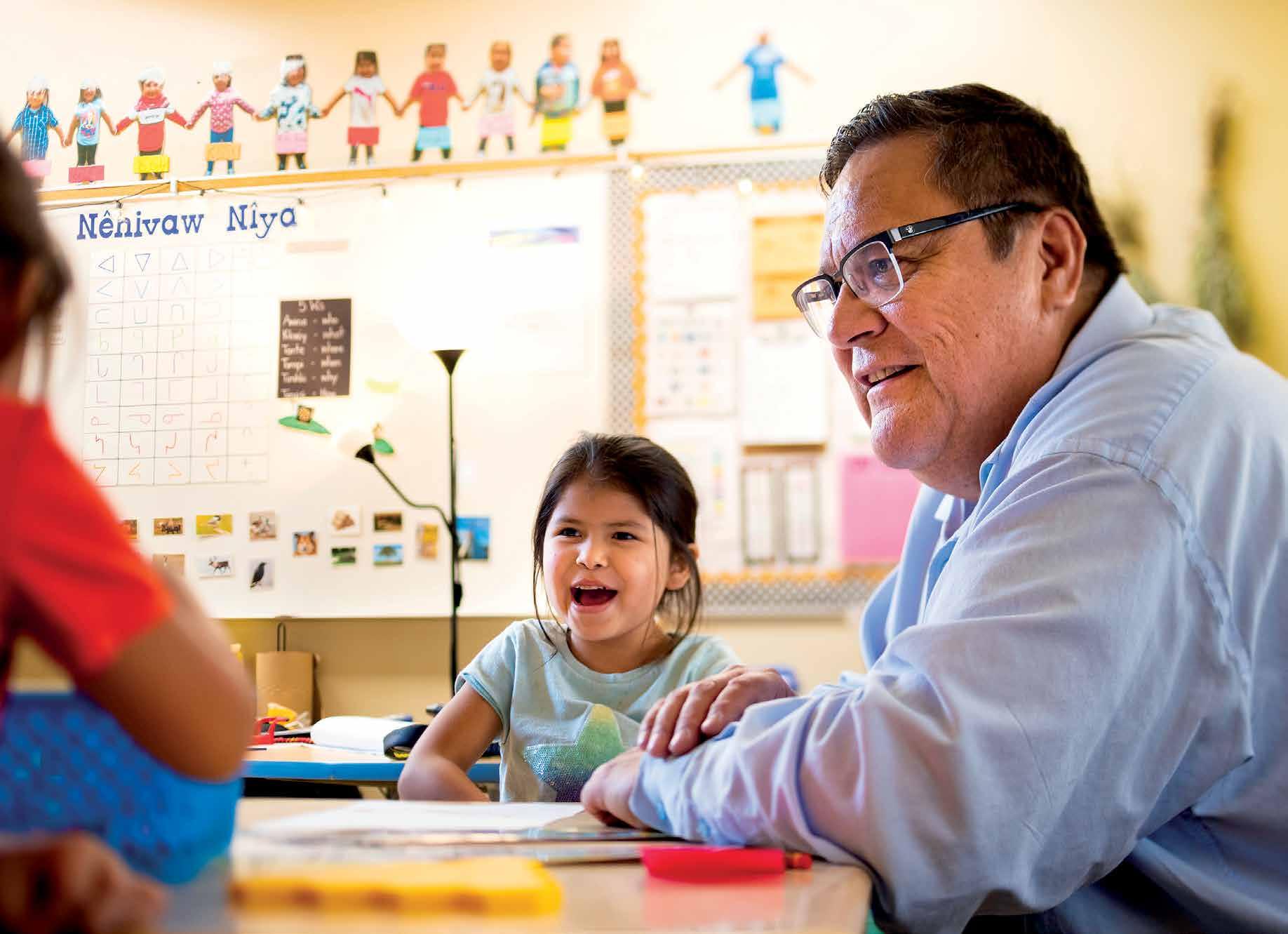
“Education is a universal human right, and more and more we are seeing an increase of Indigenous students pursuing university. This is because of those advocating for those voices who have yet to be heard (âhkamêyimok – don’t give up/keep going). The Indigenous leadership within the university is choosing to stand up and no longer be silent for the future generations, for this I am thankful (kinanāskomitin — I thank you).”

Dallas Cardinal
Project Co ordinator, Supporting Indigenous Languages Revitalization, Office of the Vice Provost, Indigenous Programming and Research
Assistant Professor, English & Indigenous Studies, Augustana Faculty
Superintendent Brian Wildcat, a U of A grad, visits with students at Ermineskin Elementary School in Maskwacîs, Alta., where his daughter, Devon Wildcat, teaches. The phrase, Nehiyaw Niya visible on the bulletin board, translates to “I am Cree.”
Untitled (1981) by Victoria Mamnguksualuk (19302016) of Nunavut is part of the University of Alberta Museums Art Collection. It depicts hunters travelling across the land. (University of Alberta Museums Art Collection; The Clifford E. Lee Collection; 1983.44.17)
67 UNIVERSITY OF ALBERTA INDIGENOUS STRATEGIC PLAN
TOP PHOTO BY RICHARD SIEMENS; RIGHT PHOTO BY JOHN ULAN
66
OWABI NEH, DON YACHENE, TAUSUM-GEH YAPKA, NAHA ABA-NEH, TAUDA-BAGE YACEMTE
Affirmation for Action by the University Community
Following the lengthy consultations informing For the Public Good in 2016, the Strategic Plan for Equity, Diversity and Inclusivity in 2018, University of Alberta for Tomorrow in 2021 and the institutional brand in 2021, the University of Alberta made broad and powerful commitments to Indigenous post-secondary education, research and engagement, and to ensuring a response to the Calls to Action issued by the Truth and Reconciliation Commission of Canada (TRC).
This affirmation aims to serve as the university’s visible commitment to respond to the TRC’s Calls to Action and broader indigenization efforts — work that remains urgent.
The calls are at the heart of the work to address the systemic barriers that limit full Indigenous participation in the offerings of the university — historical and contemporary barriers that have artificially prevented Indigenous Peoples from achieving greater individual and collective sovereignty.
In recognizing the great power of education, the TRC noted that universities have a particular responsibility, ability and opportunity to contribute to reconciliation by enacting curricular changes that correct the historic record, by incorporating reconciliation learning, by increasing Indigenous representation in professions, and by eliminating education and employment gaps for Indigenous Peoples. This document reaffirms the university’s commitment to engage with Indigenous Ways of Knowing, Being and Doing in order to acknowledge the deliberate erasure and exclusion of Indigenous knowledge systems. The same power that was employed to
disenfranchise Indigenous Peoples can now be brought to bear on the education of the students we serve and those beyond the institution.
The U of A acknowledges that indigenization is an institutional journey that will likely take generations to address. Only intentional, conscientious, systemic changes can move the institution closer to these critical goals.

In the spirit of these understandings — and with an acknowledgment that the work to indigenize the institution touches on every academic, administrative and operational aspect of the university — we, as signatories, affirm our commitment as individuals, as educators, as researchers, as administrators and as leaders to act on Indigenous Initiatives within our units and across the institution.
We invite community members, learners and all those interested in participating in this change, to sign the affirmation at uab.ca/braiding
Through the Indigenous Strategic Plan, the University of Alberta now has a path forward with specific actions to improve the university experience for students and staff. Most significant is that this document will uphold the TRC Calls to Action and UNDRIP, including the International Decade for Indigenous Languages, which recognizes Indigenous Peoples’ rights, language and culture.”
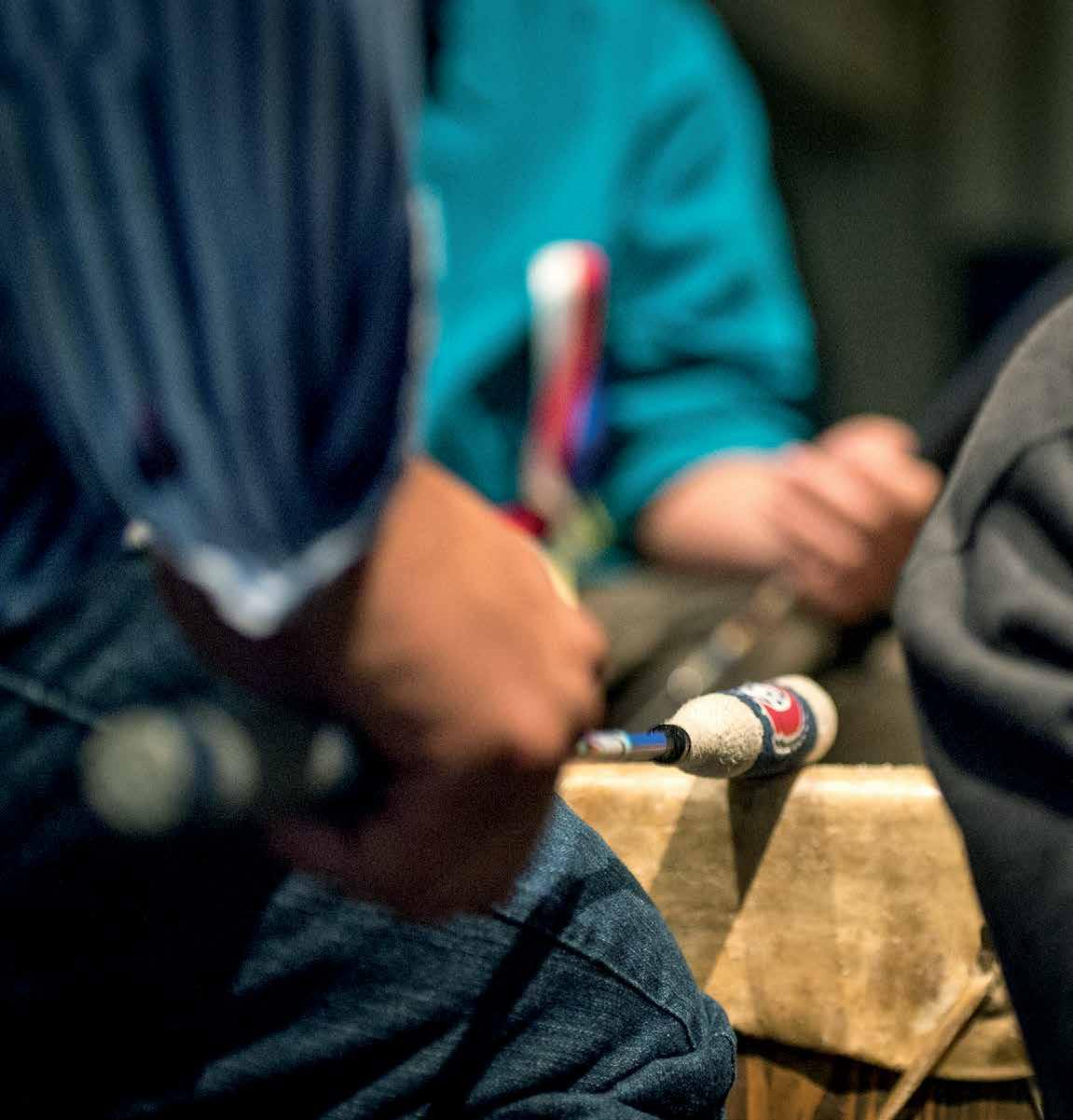 Pamela McCoy Jones
Pamela McCoy Jones
As the College of Health Sciences pursues our mandate of advancing the full spectrum of human health and wellness in individuals and communities, we are strongly committed to approaching this challenge through the lens of equity, diversity and inclusion.
In particular, we must continue to strengthen our commitment to Indigenous initiatives and leadership as we do this important and necessary work. Contending with the painful Canadian legacy of colonialism must inform every decision we make as we advance systems changes in our teaching, learning and research.
Indigenous leaders in the College of Health Sciences are guiding us in challenging past
academic approaches, building new ways of knowing, and underscoring the importance of health sciences as a powerful tool for change. There is much to do in our commitment to support Indigenous individuals and communities within our college and in the broader context of our reach, and much of that work will involve acknowledging the ways so many of our systems have fallen short. But the power of this transformation is and will continue to be profound and will build the foundation for a better and stronger collective future.”
Greta Cummings Interim Dean, College of Health Sciences
LEFT PHOTO BY RICHARD SIEMENS, RIGHT PHOTO BY JORDON HON
Executive Director, Supporting Indigenous Language Revitalization, Office of the Vice Provost, Indigenous Programming and Research
69 UNIVERSITY OF ALBERTA INDIGENOUS STRATEGIC PLAN 68 KUNAKES
To have a strategic plan made by Indigenous people who have collaborated and worked tirelessly for the future generations of indigeneity at the University of Alberta is an enormous accomplishment. Less than 50 years ago, being an Indigenous student at the U of A was a rarity and yet here we are in 2022, with students who are stronger, driven with purpose and thriving. This Indigenous Strategic Plan will be the charter for the next seven generations of students and academia alike.”
Shannon Cornelsen
Vice President, Consultation and Engagement, Indigenous Students’ Union
The IGSA sees the inherent value in envisioning a future for the university where Indigenous knowledge, lands and people are partners in leading the U of A for tomorrow. The incorporation of so many teachings and languages in this living document sets a tone for the ongoing process of truth and reconciliation that is respectful of, and values, the diversity and beauty of our Nations, languages, people and cultures. We look forward to walking this new path together, as partners in this shared vision of success for Indigenous and settler communities alike.”
Indigenous Graduate Students’ Association
Some of the photos have names listed and some do not; this respects the wish of the people in the photos.
The selected photos are a small representation of the diversity of the Indigenous people and initiatives at the University of Alberta. They do not capture all of the Indigenous spaces, initiatives or individuals.

Endnotes

1 Truth and Reconciliation Commission of Canada, Honouring the Truth, Reconciling for the Future (PDF), 2015, Summary of the final report of the Truth and Reconciliation Commission of Canada, available at: https://ehprnh2mwo3. exactdn.com/wp-content/uploads/2021/01/Executive_Summary_English_Web.pdf [accessed 1 June 2022], p.1.


2 Truth and Reconciliation Commission of Canada, Honouring the Truth, Reconciling for the Future (PDF), 2015, Summary of the final report of the Truth and Reconciliation Commission of Canada, available at: https://ehprnh2mwo3. exactdn.com/wp-content/uploads/2021/01/Executive_Summary_English_Web.pdf [accessed 1 June 2022], p.8.

3 Assembly of First Nations, Dismantling the Doctrine of Discovery, January 2018, available at: https://www.afn.ca/wp-content/uploads/2018/02/18-01-22Dismantling-the-Doctrine-of- Discovery-EN.pdf, [accessed 21 May, 2022].
4 For an explanation of terra nullius, please see Assembly of First Nations, Dismantling the Doctrine of Discovery, January 2018, available at: https://www.afn. ca/wp-content/uploads/ 2018/02/18-01-22-Dismantling-the-Doctrine-of- DiscoveryEN.pdf, [accessed 21 May, 2022].

5 UN General Assembly, United Nations Declaration on the Rights of Indigenous Peoples resolution/adopted by the General Assembly, 2 October 2007, A/ RES/61/295, available at: https://www.refworld.org/docid/471355a82.html [accessed 29 April, 2022], p.3.
6 UN General Assembly, United Nations Declaration on the Rights of Indigenous Peoples resolution/adopted by the General Assembly, 2 October 2007, A/ RES/61/295, available at: https://www.refworld.org/docid/471355a82.html [accessed 29 April, 2022].
7 Library of Parliament, Legal and Social Affairs Division, Parliamentary Information and Research Service, Isabelle Brideau, Background Paper: The Duty to Consult Indigenous Peoples, Publication No. 2019-17-E, 12 June, 2019, available at: https:// www.rcaanc-cirnac.gc.ca/eng/1331832510888/1609421255810 [accessed 29 April 2022], p.1.
8 Truth and Reconciliation Commission of Canada, Honouring the Truth, Reconciling for the Future (PDF), 2015, Summary of the final report of the Truth and Reconciliation Commission of Canada, available at: https://ehprnh2mwo3. exactdn.com/wp-content/uploads/2021/01/Executive_ Summary_English_Web.pdf [accessed 29 April 2022], p.8.
9 Gaudry, Adam, and Danielle Lorenz. 2018. “Indigenization as Inclusion, Reconciliation, and Decolonization: Navigating the Different Visions for Indigenizing the Canadian Academy.” AlterNative: An International Journal of Indigenous Peoples 14 (3): 218–27. https://doi.org/10.1177/1177180118785382.
LEFT PHOTO BY JOHN ULAN; RIGHT PHOTO GETTY IMAGES
71 UNIVERSITY OF ALBERTA INDIGENOUS STRATEGIC PLAN 70 AHPIKAHTEYKIN
MEY’OOSNZAH, NOONGKOM SIKWA OOTIH NIIGKAN
Together, we are leading with purpose.
Office of the Vice-Provost, Indigenous Programming and Research
2-29 South Academic Building
Edmonton, AB
Canada T6G 2G7
uab.ca/braiding






































 Lana Whiskeyjack
Professor,
Assistant
Faculty of Arts, Women’s and Gender Studies
The Young Indigenous Women’s Circle of Leadership creates opportunities for participants to learn about aspects of their culture and identity through various activities, rooted in nehiyawewin (Cree language).
Lana Whiskeyjack
Professor,
Assistant
Faculty of Arts, Women’s and Gender Studies
The Young Indigenous Women’s Circle of Leadership creates opportunities for participants to learn about aspects of their culture and identity through various activities, rooted in nehiyawewin (Cree language).





 Trevor J. Phillips Manager, Indigenous Recruitment, Office of the Registrar
Trevor J. Phillips Manager, Indigenous Recruitment, Office of the Registrar











































 Aminah Robinson Fayek Vice President, Research and Innovation
Aminah Robinson Fayek Vice President, Research and Innovation
 Paul Gareau Assistant Professor, Faculty of Native Studies
Janice Makokis, a legal scholar and U of A grad from Saddle Lake Cree Nation, at the Kikino Métis Settlement.
Paul Gareau Assistant Professor, Faculty of Native Studies
Janice Makokis, a legal scholar and U of A grad from Saddle Lake Cree Nation, at the Kikino Métis Settlement.










 Pamela McCoy Jones
Pamela McCoy Jones

